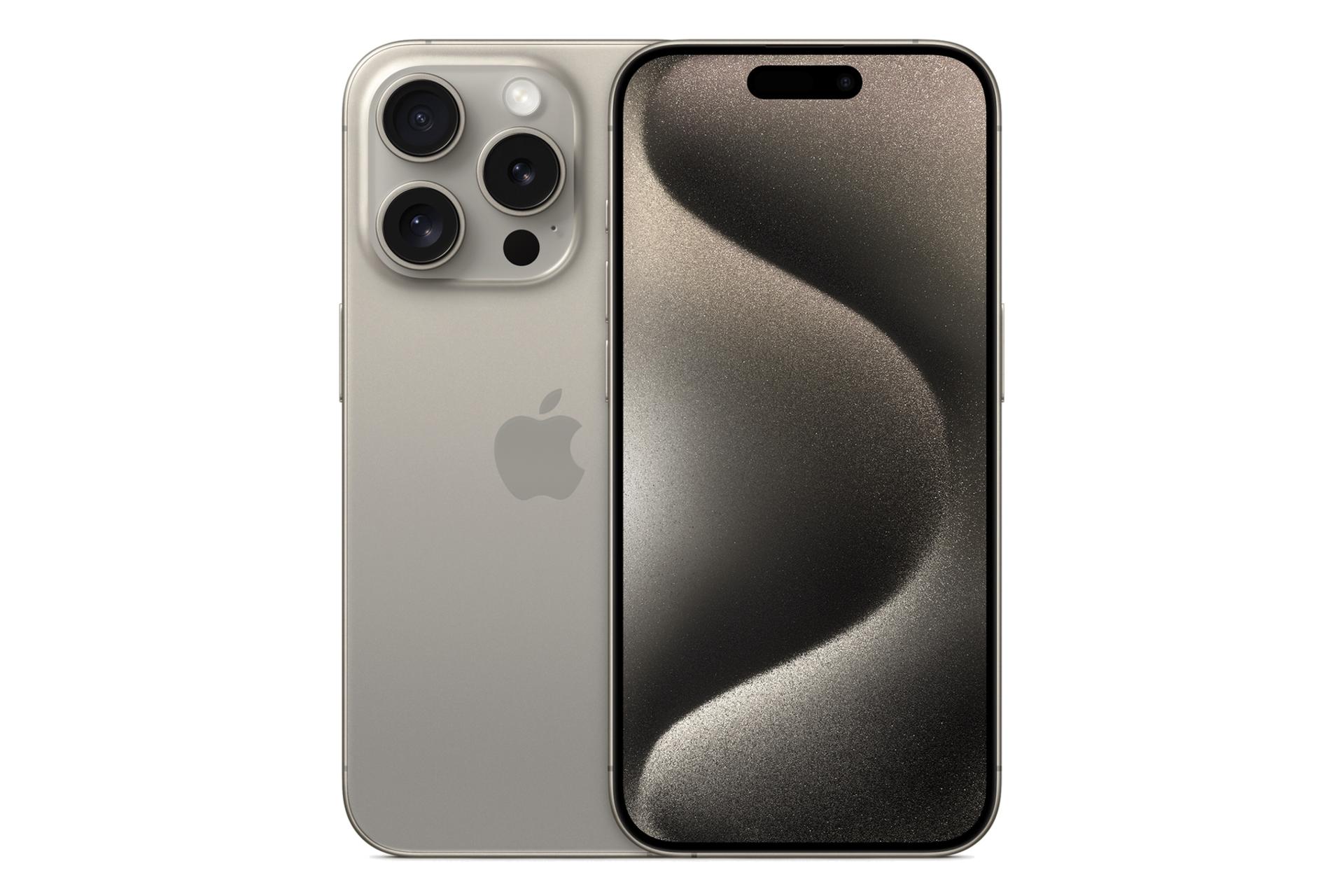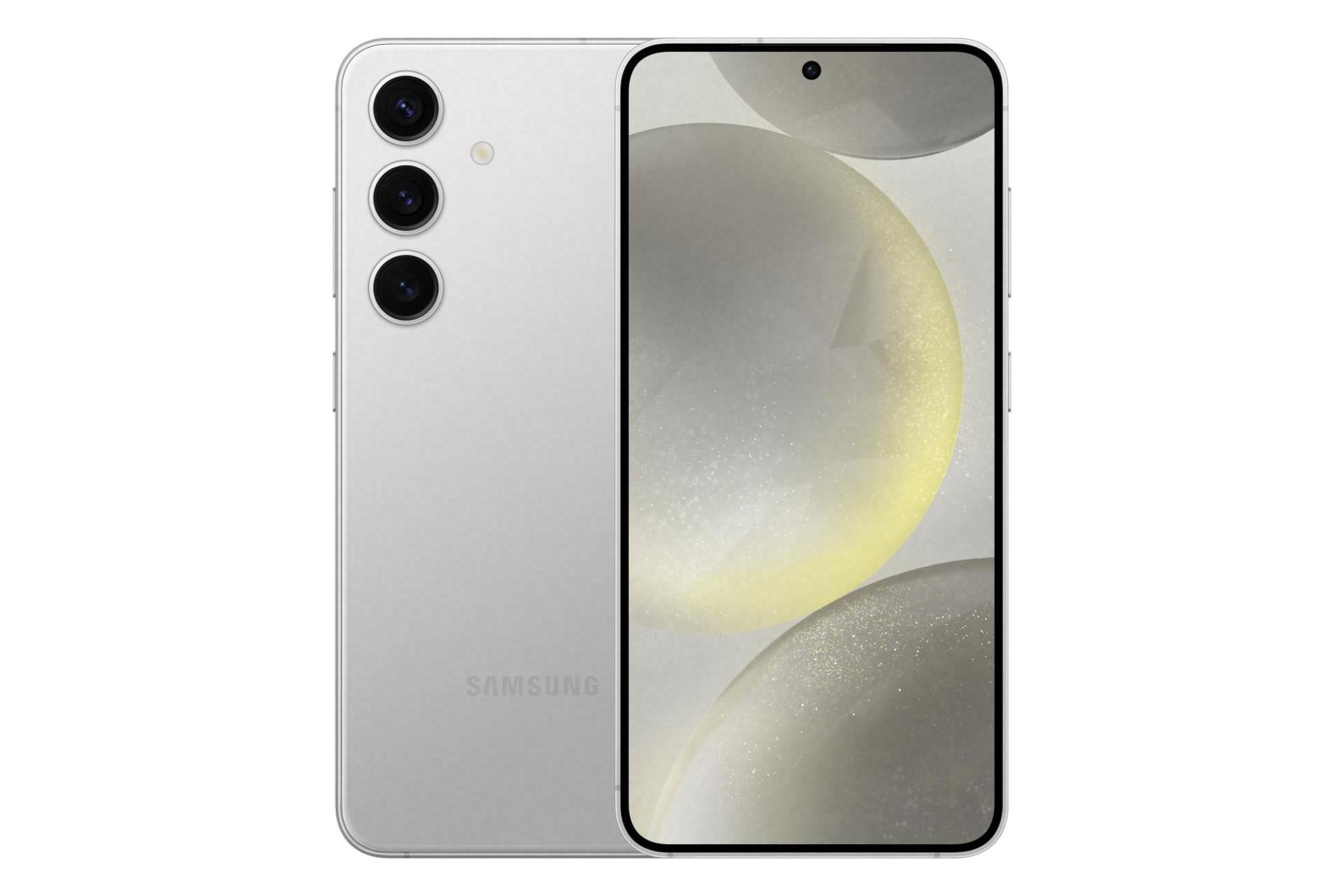Technology
The story of the Yahoo brand, the story of the fall of a unicorn startup
Published
7 days agoon
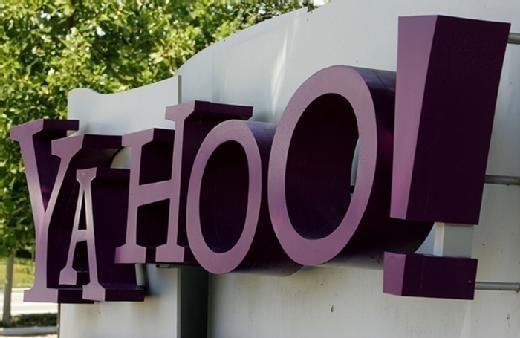

The story of the Yahoo brand, the story of the fall of a unicorn startup
In the history of the technology world, there are many companies that used to be empires; But over time, they reached the carpet and now only a part of their business is active. Yahoo was one of these companies that once ruled the world of the Internet. However, at the beginning of the new century, the company was in a downward spiral, and it went to the point where Verizon bought the majority of Yahoo shares in 2017 for $4.48 billion.
At the beginning of the 21st century, Yahoo was the most visited website on the Internet and was valued at $125 billion (about three times the current value of Twitter). The company’s services included a search engine, Yahoo Mail, Yahoo Messenger, and a web hosting service. Many of you, like me, have probably had the experience of using Yahoo Mail and the Yahoo search engine, and even your first acquaintance with the online chat world was with Yahoo Messenger.
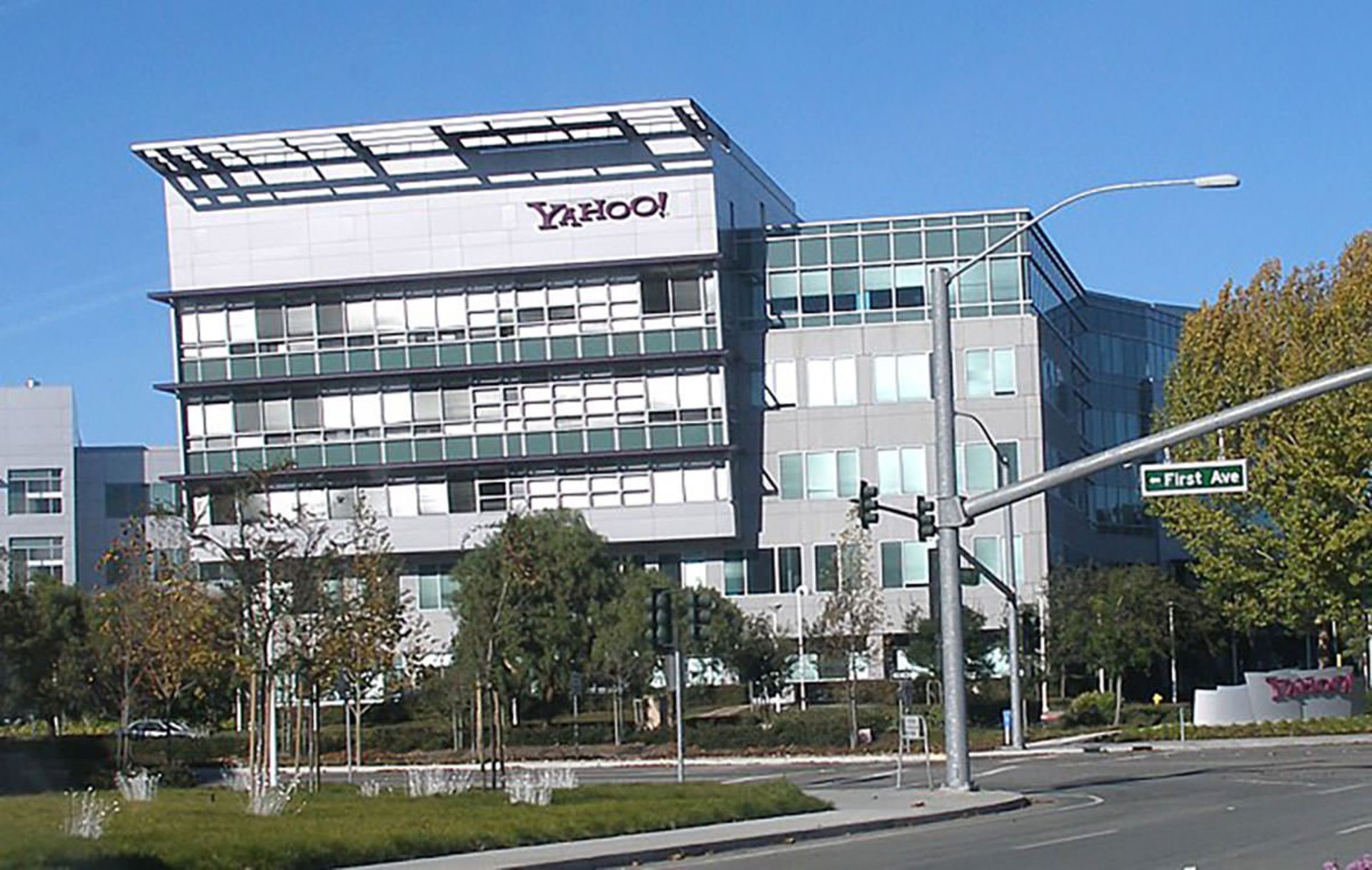 Yahoo Management Center in Sunnyville
Yahoo Management Center in Sunnyville
In those days, Yahoo’s power was equal to the combined power of Facebook and Google; But what happened to Yahoo and how did it suffer such a fate? In the continuation of the series of brand story articles, I have narrated the history and story of the Yahoo brand from its birth to its fall in four chapters. stay with me
Table of contents
-
Chapter 1: Birth of Yahoo!
-
The story of two smart students
-
Long live the founders of Yahoo!
-
Formation of Yahoo!
-
Yahoo growth at the speed of light
-
Combination of youth and experience
-
Launching Yahoo’s first monetization model
-
Million dollar income
-
Chapter 2: Growth of Yahoo!
-
Yahoo in the capital market
-
Start advertising
-
Yahoo in development
-
Launching the most popular service
-
Investing and being among unicorns
-
95 million daily visits
-
Yahoo’s big mistake
-
Launch Yahoo Messenger
-
The new century and the presence of new competitors
-
The return of the brilliant era for Yahoo!
-
The risk of failure lurks in Yahoo
-
A way to beat Google
-
Chapter 3: Fall of Yahoo!
-
The beginning of the crisis
-
The season of changes
-
Unsuccessful attempts
-
Google intern, head of Yahoo
-
Mayer’s management
-
A big challenge for Yahoo
-
Tax evasion attempt
-
Chapter 4: Current Yahoo!
-
Purchase offer
-
Disclosure of Yahoo users’ information
-
Complete liquidation of Yahoo!
Chapter 1: Birth of Yahoo!
How was Yahoo formed and where did the idea for its development come from? In the first chapter of the Yahoo brand story, I have examined the formation and birth of this brand.
The story of two smart students
The story of the formation of Yahoo, like many other technology giants, is tied to two students; Jerry Young and David Philo. These two PhD students, who were studying electrical engineering at Stanford, came up with the idea of creating a website with the possibility of categorizing different websites in 1994 while working on their thesis.
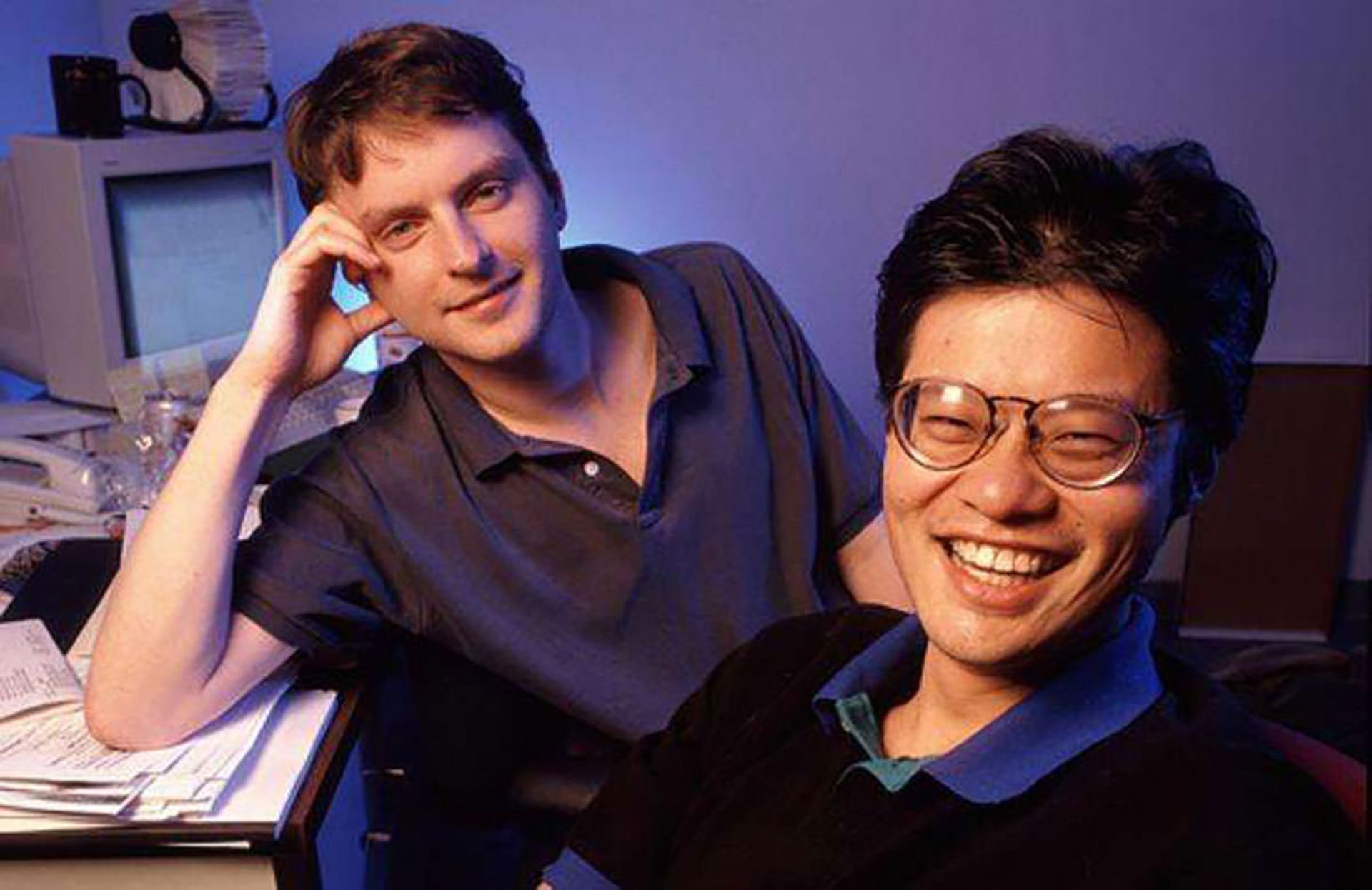 Yang and Philo, the founders of Yahoo!
Yang and Philo, the founders of Yahoo!
Young and Philo, who spent most of their free time surfing the web, cataloged their favorite websites. Eventually, they designed and launched a personal website that allowed users to access the duo’s popular websites on the Internet. At that time, the website of these two Stanford students was known as “Jerry’s Guide to the World Wide Web”. Yang and Philo probably didn’t think what a tumultuous future awaited them by putting their idea into practice.
Long live the founders of Yahoo!
In a short period of time, the number of users of Jerry and David’s website experienced a significant increase. This remarkable reception made the founders devote more time to the development and improvement of their website. Over time, their website evolved from a jumbled list of various websites created for fun to a well-organized database where users could search for the website they were interested in. The initial database named akebono was stored on Jerry’s student workstation computer at Stanford University. The search engine was stored in Philo’s computer and was known as Konishiki. It may be interesting to you that the name of these computers was chosen based on the names of sumo wrestling champions.
Jerry and David’s personal website has become a regular database for searching various websites.
Formation of Yahoo!
The story of how Yang and Philo’s original website was renamed to Yahoo is very interesting. After some time, the founders got tired of the long initial name of the website and thought of using an alternative and shorter phrase. They first sought to use the acronym YACC, an acronym for Yet Another Compiler Compiler, one of the popular expressions among Unix fans. Of course, after some discussion to find a more beautiful name, Yang and Philo came up with YAHOO, an abbreviation of Yet Another Hierarchical “Officious Oracle”. The word “Hierarchical” refers to the hierarchical arrangement of the database in directory layers, the word “Officious” refers to the administrative staff who used the database, and “Oracle” refers to the “source of truth and wisdom”.
 Yahoo in 1994
Yahoo in 1994
Jerry and David went to Webster’s online dictionary to find the meaning of yahoo, and to their surprise, they found out that Yahoo means “rude and disheveled.” Young was known to be foul-mouthed during his student days, and Philo also spoke bluntly; For this reason, the founders of Yahoo considered themselves suitable to define the mentioned word! Finally, a brand was born that would change the meaning of the word Yahoo for web users for a few years to come.
Yahoo growth at the speed of light
Shortly after the start of Yahoo’s activity in the Internet world, the reception of users was so great that Yang and Philo’s computers were no longer responsive to incoming traffic. In early 1995, Netscape co-founder Marc Andreessen suggested Yang and Philo move Yahoo to a more powerful computer at Netscape. The relocation was particularly welcome for Stanford University, as Yahoo’s inbound traffic was putting a lot of strain on its network infrastructure. In fact, Yahoo was growing at the speed of light.
The move of Yahoo’s servers to Netscape was most welcome for Stanford University
Combination of youth and experience
After a while at Yahoo, Jerry and David realized that it was not easy for them to maintain both the creative and managerial aspects of a growing startup. For this reason, they asked Timothy Koogle, one of Stanford’s former students, to work as CEO at Yahoo. Kugel studied at the Faculty of Engineering and his work history was related to engine rebuilding and car repair. Of course, he approached the world of technology after some time and had a working history at Motorola and Intermac.
One of the first important and influential actions of Kugel in Yahoo is the hiring of Jeff Mallett (Jeff Mallett) as the director of operations. With a history of being a member of the Canadian national football team, Mallet entered the world of business and management at the age of 22. He performed sales, marketing, and business development activities in his parents’ family company in the telecommunications industry.
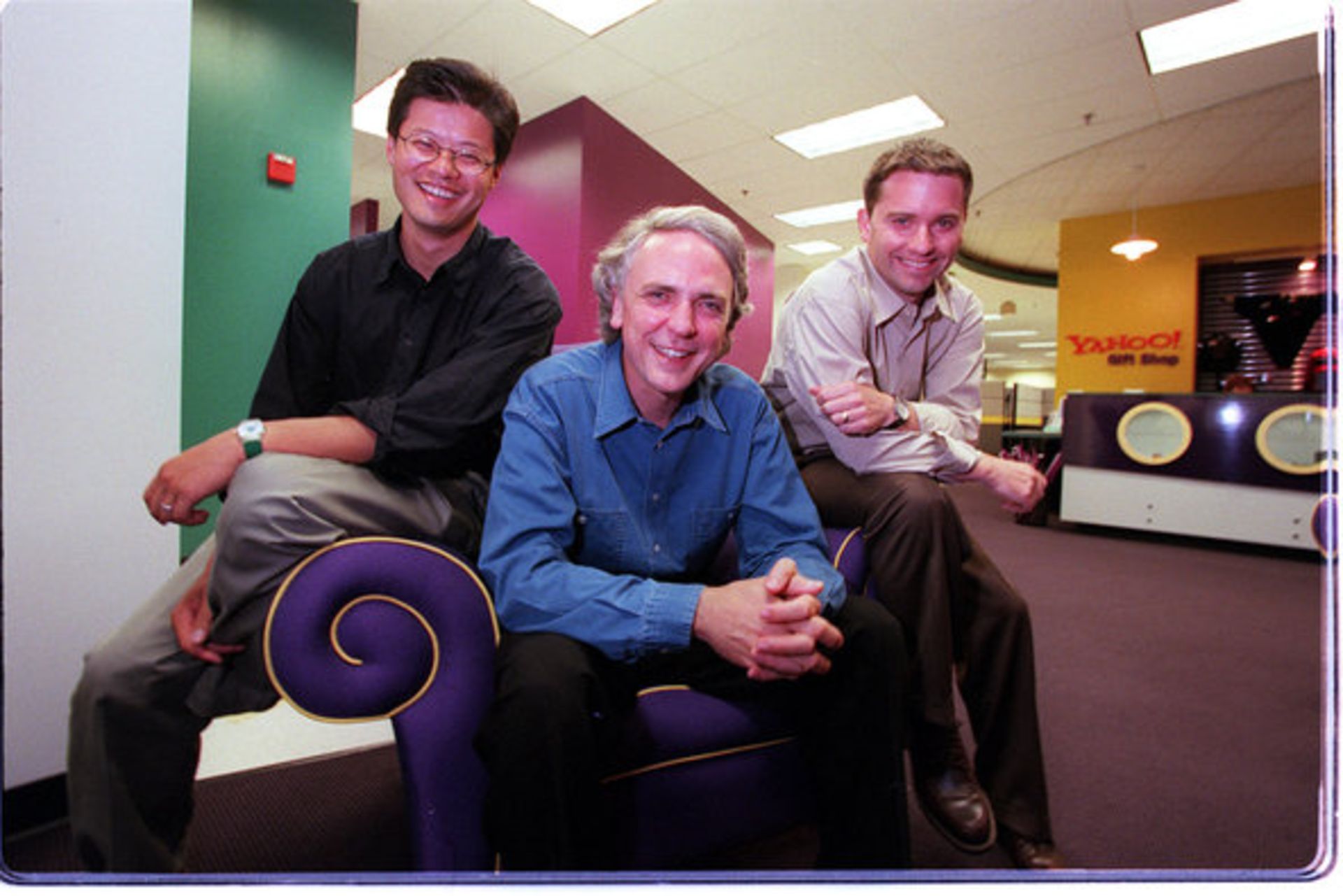 From left: Jerry Young (Founder), Timothy Kugel (Senior Director) and Jeff Mallet (Chief Operating Officer)
From left: Jerry Young (Founder), Timothy Kugel (Senior Director) and Jeff Mallet (Chief Operating Officer)
Before joining Yahoo, Mallet worked at Reference Software and WordPerfect companies and learned the principles of professional marketing from them. Among his other records, it can be mentioned that he was the senior vice president of Novell’s computer department. Mallet and Kugel together turned Yahoo from a simple website directory into one of the most popular services in the world of information technology. Maybe if Mallet and Kugel did not responded positively to the request of the founders of Yahoo, Yahoo would not have experienced much growth.
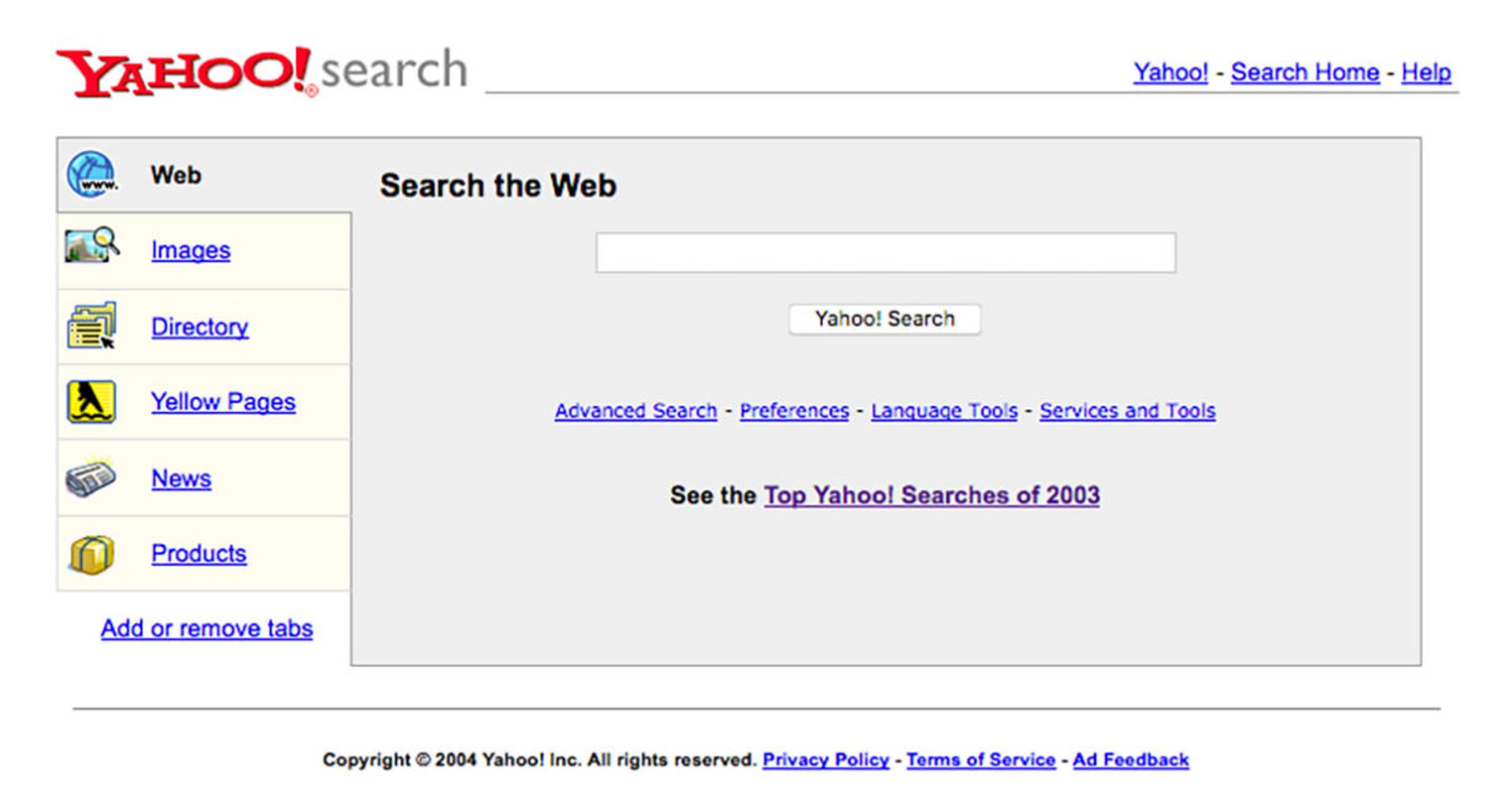
Kugel and Mallet were known as Yahoo’s “parents” in the company after a while. While Young and Philo showed up at work in sportswear and t-shirts, Kugel and Mallet had a businesslike look similar to traditional managers. People around this four-member team considered it similar to a group in which two children present their ideas and the adults are responsible for implementing the ideas. The media and analysts of the technology world had almost the same thoughts about Yahoo and its group of managers at the beginning of the new century. Young and Philo had interesting ideas that attracted users, they said. Mallet and Kugel turned those ideas into a structured business that led to increased funding and advertising.
Launching Yahoo’s first monetization model
The combination of youth and experience made Yahoo’s monetization model launch quickly. Yahoo’s major income in the early years was earned from the sale of banner ads. Yahoo sells advertising space on its web pages. Businesses also used these spaces to advertise their products to Yahoo users; This is exactly what is seen in many internet services today.
Yahoo’s banner ads not only visually attracted the user to the target product, but often contained a link to the website of the business buying the ad. Unlike traditional TV, radio, and magazine ads, banner ads directly connect the buyer to the advertising company; As a result, the use of this type of advertising became extremely popular.

Another part of Yahoo’s income was obtained through cooperation with online retailers. Yahoo was not an online retailer, but it had significant traffic. On the other hand, online sales websites needed more traffic to display their products on their dedicated website and increase sales. By directing users to Hedayat’s retail websites, Yahoo received commissions from product sales. As a result, Yahoo gradually became a “portal” and played the role of a gateway to other parts of the Internet. Yahoo was not the only platform for this work and Excite, Infoseek and Lycos were among the powerful competitors of this website.
Million dollar income
Yahoo was able to continue operating for free thanks to the income it received from advertisements and online sales fees; While other services such as AOL, Prodigy, and Microsoft Network were offering paid services. Yahoo was the best destination for people looking for free internet services. Although Yahoo’s competitors had a nicer and more graphical look to their services, they offered the same services for a fee.
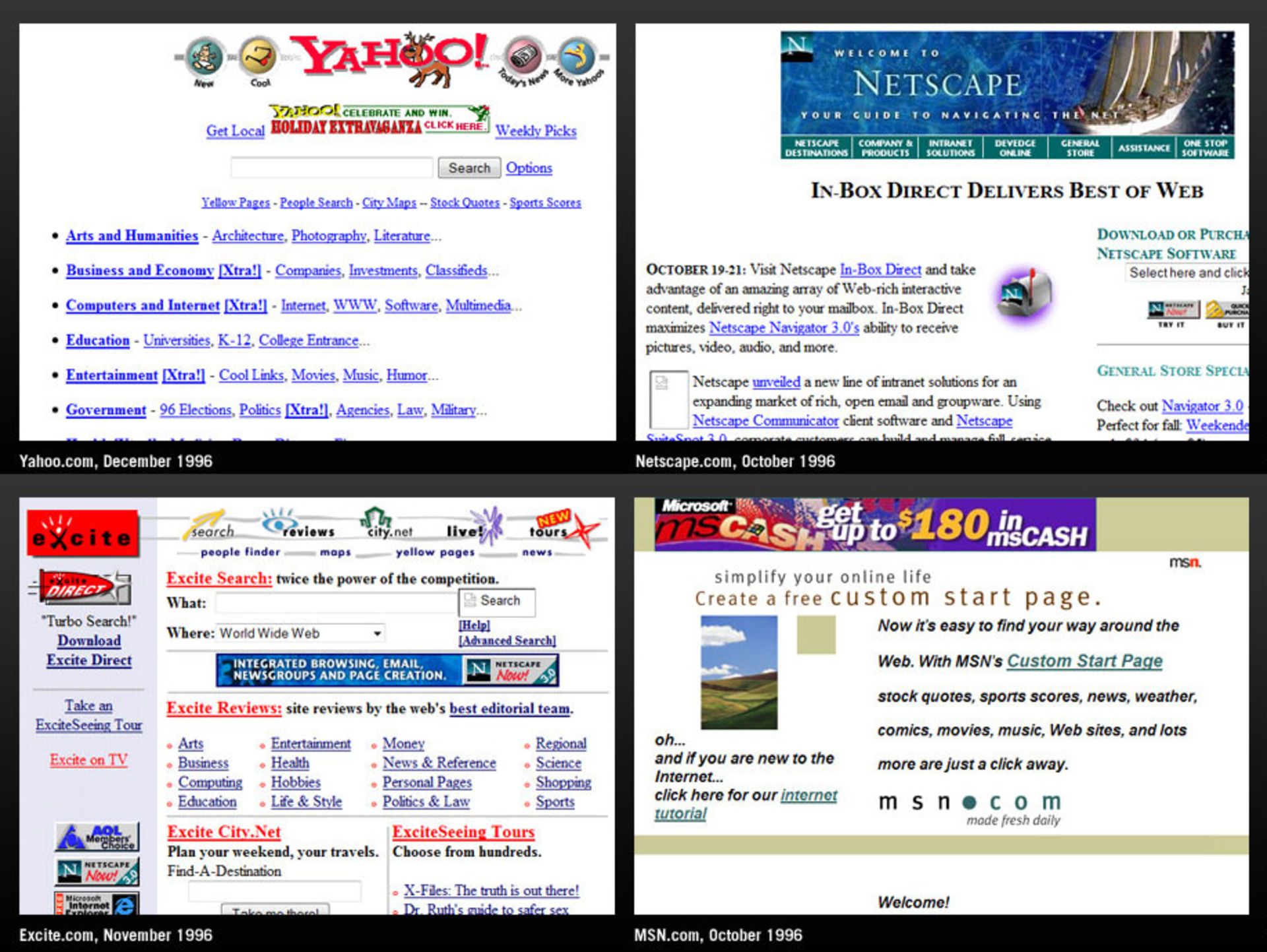
Although Yahoo was not very profitable at first and earned only one million dollars in 1995 after a while it overtook old giants such as AOL. This company, like Amazon, was a successful brand focused on user satisfaction.Chapter 2: Growth of Yahoo!
Yahoo needed less than two years to be on the path of growth and development. In this chapter of Yahoo’s story, we examine the growth stage of this brand step by step.
Yahoo in the capital market
In 1996, Yahoo shares were publicly traded at a price of $13 per share. On the first day, the company’s stock value reached $43. Forecasters valued Yahoo at nearly $300 million, 15 times the company’s 1996 revenue.
Start advertising
After offering Yahoo shares in the capital market, Yahoo managers decided to introduce their brand to more users through advertisements. Executives hired another Stanford graduate, Karen Edwards, to develop the company’s brand. He signed a contract with the advertising agency Black Rocket to handle Yahoo’s advertising. You might be interested to know that BlackRocket was run by four advertising executives, none of whom owned a computer.
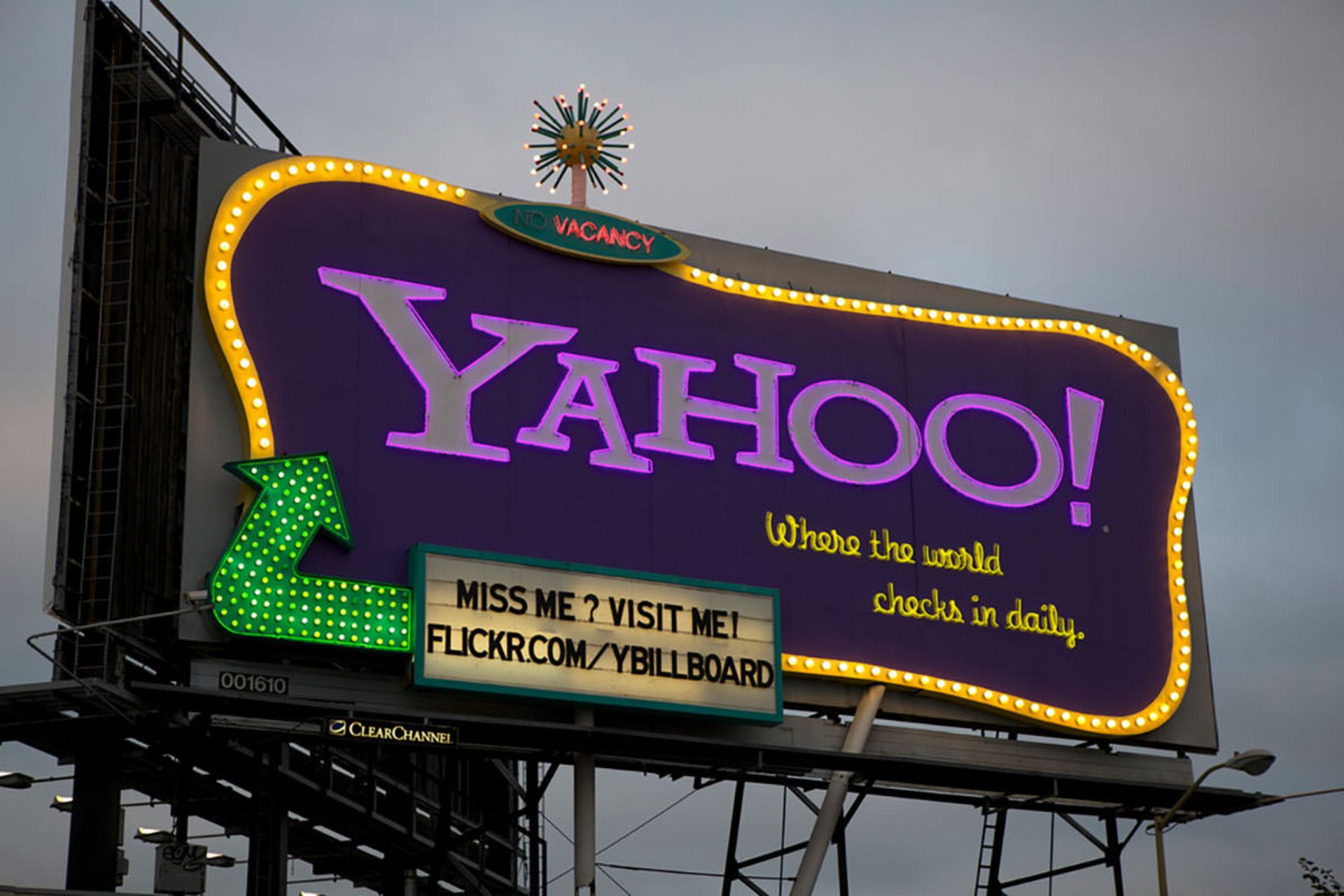
In the spring of 1997, Yahoo spent almost all of its advertising budget on a national US campaign to run television ads. Yahoo’s advertising campaign was a significant success and played an important role in introducing the brand, especially to American users.
Yahoo’s marketing plans were trying to put this brand in front of people’s eyes everywhere
Managers used simple concepts and far from focusing on the technological capabilities of their service to promote Yahoo’s achievements and possibilities. They eventually sought to transform their company into a full-fledged media company. Yahoo’s marketing campaign also took an aggressive approach. Marketing managers displayed the company’s logo in every possible place so that people get to know this symbol and new name as much as possible.
Yahoo in development
After Yahoo became a trusted and well-known brand on the Internet, the company sought to increase its services to keep up with other competitors, especially AOL. They added services such as chat, online shopping and news to the main website so that more and more users can see the complete experience in Yahoo. Also, a feature called My Yahoo was added to the website, which allowed users to personalize the home page. As a result, each user saw only the content of his interest on the main page of Yahoo. With the addition of the aforementioned services to Yahoo, this search engine became more popular among users.
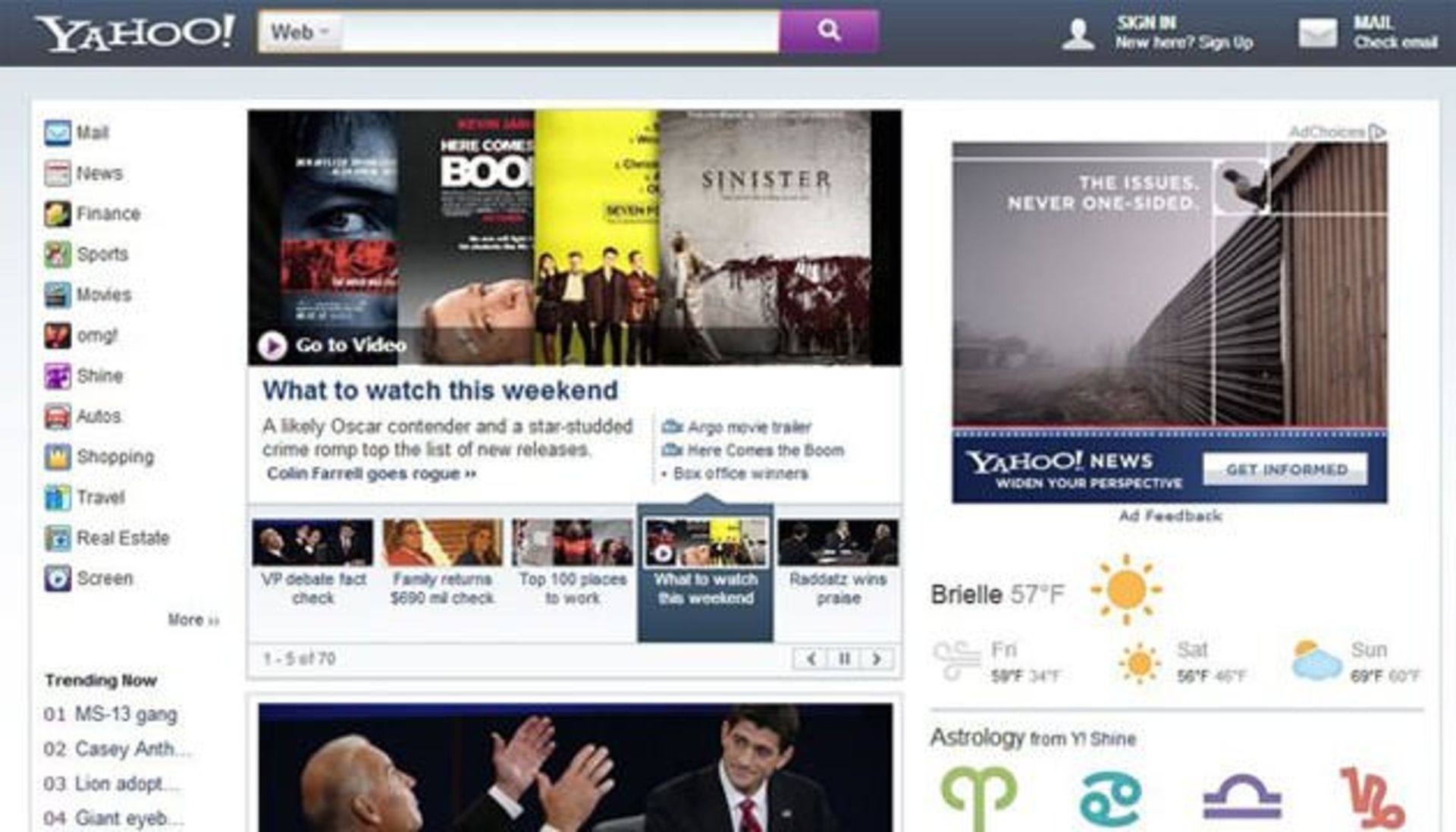
In expanding its field of activity, Yahoo sought cooperation with other large companies. They first partnered with Visa to launch an online store chain; An idea that was never implemented. A subsequent partnership with Ziff-Davis was planned to launch an online and print magazine called Yahoo! Internet Life was launched, but it still did not work. Netscape also decided to work with Yahoo to implement a topic-based Internet service in its browser, but it didn’t work out.

Launching the most popular service
In 1997, Internet users used Yahoo to browse 65 million web pages daily. This impressive reception made the managers of this company think of launching a new service. In the same year, Yahoo acquired the information company Four11 for $95 million.
In 1998, the number of monthly Yahoo users reached 40 million
The purchase of the information company Four11 gave Yahoo the possibility to use the features of the email service. These features in combination with Yahoo’s previous email service made the company succeed in offering free email to users (Yahoo! Mail). This service was considered one of the strong points of Yahoo you probably have the experience of creating a user account in this service.
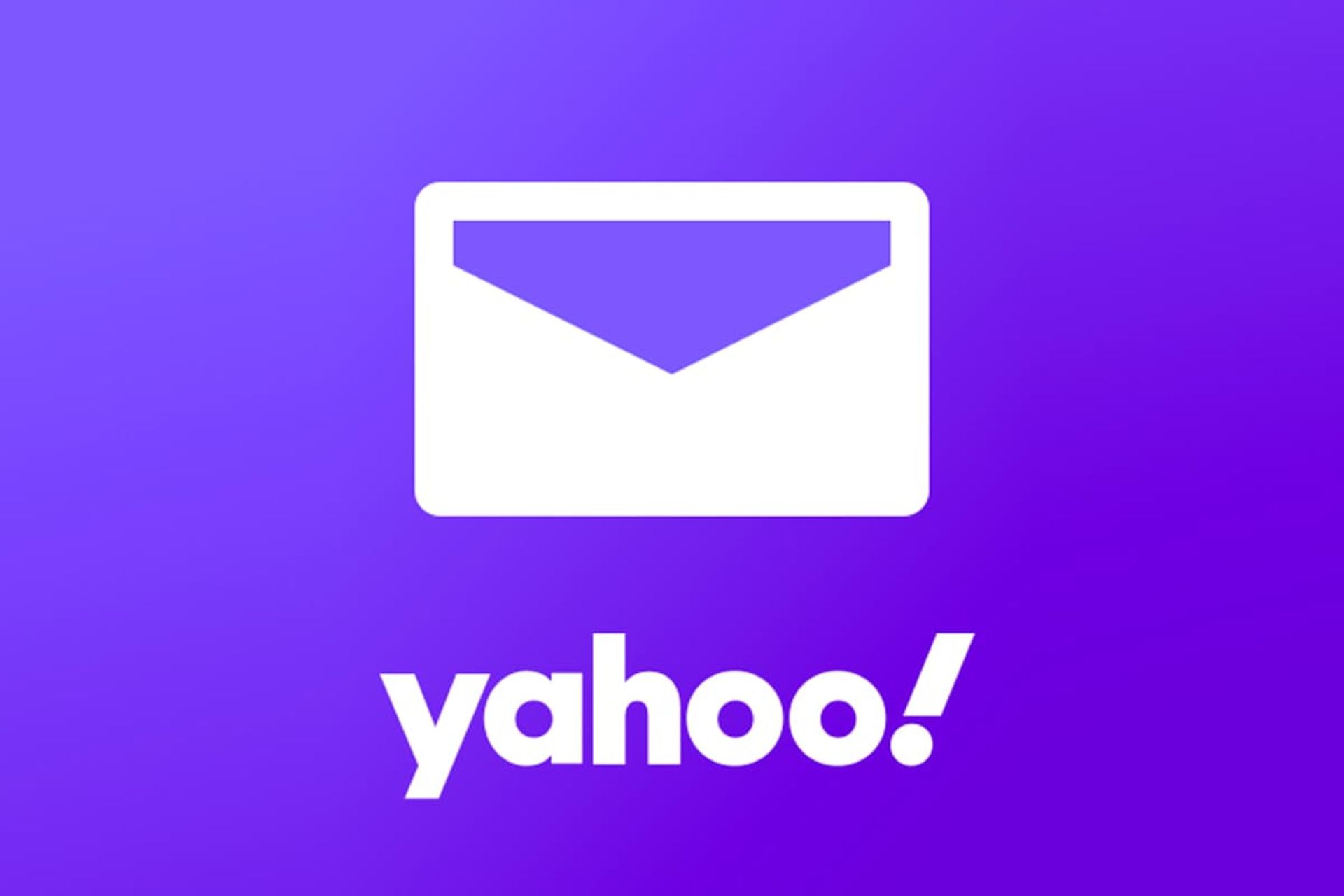
It may be surprising that the number of Yahoo users in the middle of 1998, when the Internet was not so widespread, had reached 40 million monthly users, 12 million of whom were email service users. The new figures make Yahoo a serious competitor to AOL.
Investing and being among unicorns
One of the important investments in Yahoo on the eve of the new century was made by Japan’s Softbank. The company increased its shares to 31% by paying $250 million. At that time, Yahoo had already entered the group of unicorns, and the valuation of this Internet startup was estimated at 6.9 billion dollars. A valuation that was higher than most media companies.
Based on these developments, Yahoo decided to expand its field of activity. They were looking to enter the internet connection services industry and Yahoo! Online was launched. Yahoo’s first partner was MCI Worldcom, which did not work with them for more than a year. For this reason, the managers went to AT&T to provide the desired Internet service based on AT&T WorldNet.
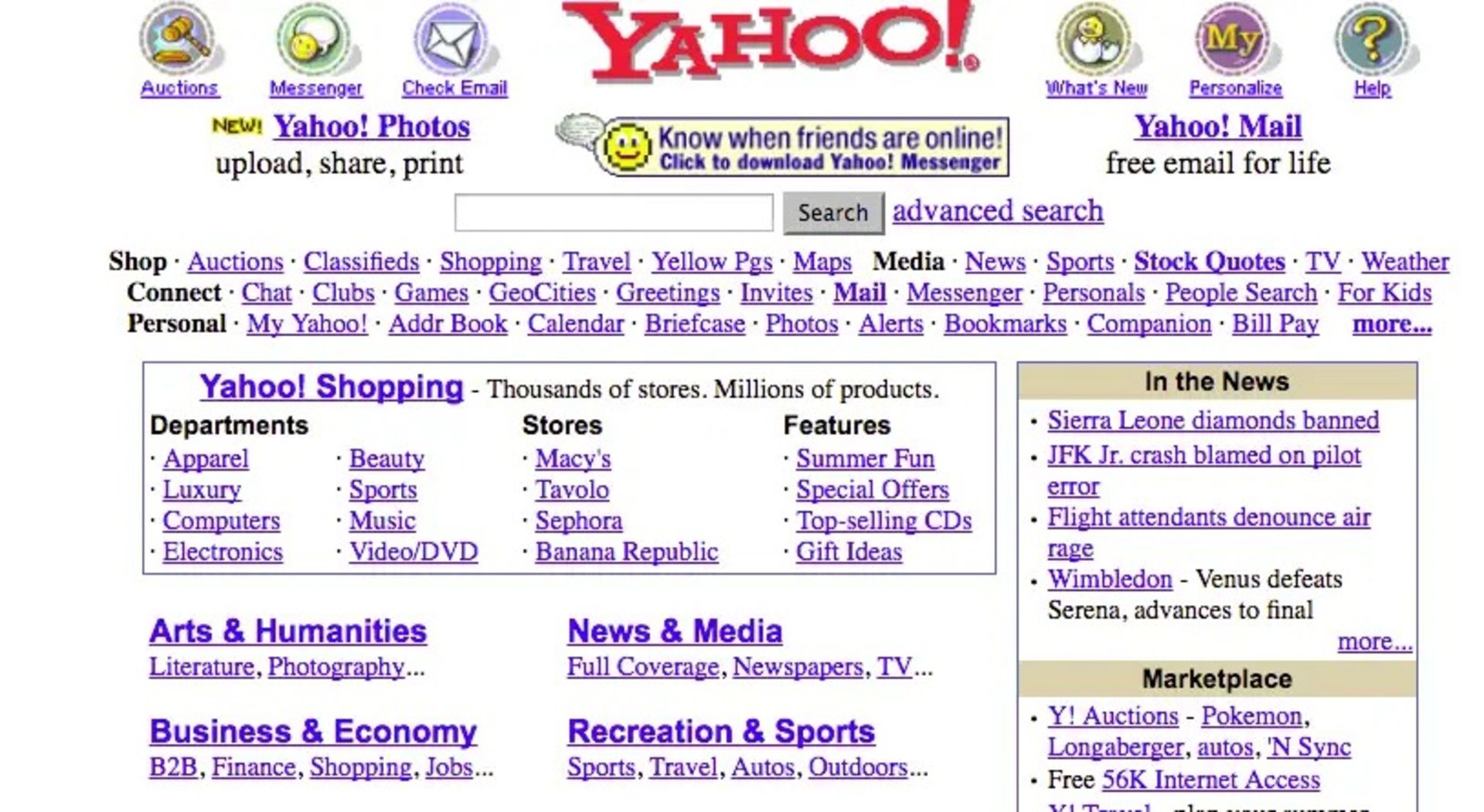
Yahoo used the services of other companies for its search engine. They used Digital Equipment until 1998 with Alta Vista but then partnered with California-based Inktomi. Another important event of Yahoo in 1998 is the purchase of Viaweb, a producer of Internet software, which was done by paying 44 million dollars. By buying the new company, Yahoo tried to give its users the possibility of developing a personal website using its software. Websites that were generally launched with the aim of buying and selling goods online.
Continuing its investments, Yahoo acquired Yoyodyne Entertainment in 1998 through a stock transfer. The new company provided Yahoo with various capabilities such as a valuable database of customers and similar assets.
95 million daily visits
At the end of 1998, Yahoo’s page views had reached a significant record and showed the number of 95 million daily. A statistic that was a significant improvement compared to the previous year. This statistic was extraordinary for the years when many people in the world did not have access to the Internet.
Yahoo’s big mistake
Yahoo had the chance to buy Google, the search engine giant of today. In 1998, the company was able to purchase the search engine technology developed by two other Stanford students, Larry Page and Sergey Brin, for $1 million. Finally, this deal, which was proposed by the founders of Google, did not start. Maybe if Yahoo had bought Google, this company would not have fallen and today it could be the largest search engine in the world.
Yahoo executives could once pay a million dollars to own Google
Regarding the deal, David Philo negotiated with the founders of Google and suggested they talk to Michael Moritz. Moritz later invested in Google through Sequoia Capital. Jeremy Ring, one of Yahoo’s senior executives from 1996 to 2001, said of the proposal:
The offer to buy Google by paying one million dollars was probably the best offer in the history of Silicon Valley, California, the United States, the planet Earth and the Milky Way!
Launch Yahoo Messenger
In 1998, Yahoo developed a product that soon became one of the main strengths of the company. Yahoo! Pager was unveiled on March 9, 1998, combining messaging capabilities with other services such as Yahoo! Chat provided. The main features of Pager include messaging, audience groups with support for user status messages, the ability to block users’ calls, alert notifications when other users go online, and email alerts. This comprehensive software client was released in 2000 to Yahoo! Messenger and has been renamed. A brand that became more famous than many Yahoo services in the following years.

The new century and the presence of new competitors
At the beginning of the 21st century, the personal computer industry, and especially the Internet was full of new players. NBC had entered the competition by investing in the Internet portal! Snap is owned by CNET. On the other hand, Disney also had an eye on this market and bought 43% of Infoseek shares. Home Corporation bought another famous portal, Excite, and Microsoft also increased the investment and development of MSN.
One of the new giants that entered the Internet world is America Online, which sought to increase its market share by purchasing Netscape and the Netcenter portal. However, many analysts predicted that the future of the media industry would be on the Internet, and for this reason, large companies were showing all their efforts to gain a share of the new industry. With the presence of new players in the Internet industry, Yahoo had a hard time to maintain its position. It goes without saying that Kugel stepped down as CEO of Yahoo in 2001 and was replaced by Terry Semmel.
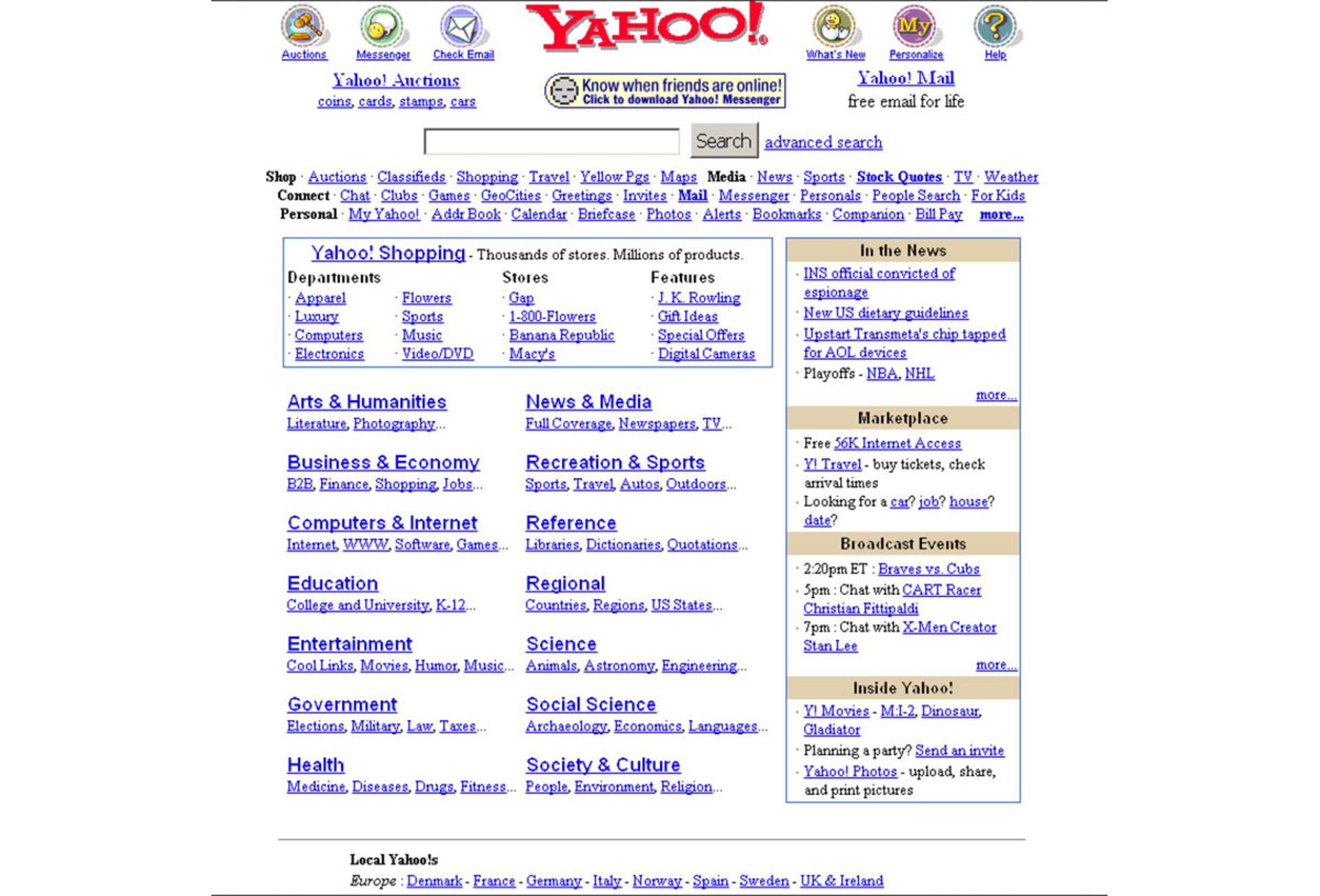
By continuing to focus on customers and their satisfaction, Yahoo was doing its best to maintain its significant market share. Yahoo executives knew that it would only take one click for a customer to leave their website and go to a competitor’s website. For this reason, they tried to provide more services to users. In 1999 GeoCities was purchased by Yahoo, which in December 1998 was named the third most visited website in the world after AOL and Yahoo.
Yahoo survived the fallout from the bursting of the dot-com bubble in the 21st century
Geocities allowed users to have their own web pages and provided them with a means of communication. Yahoo hoped that the new acquisition would lead to the exchange of users of the two services and help the growth of both. Don’t forget that Yahoo was one of the few startups that survived the dot-com bubble burst in the 21st century, but their stock still hit a record low of $8.11 in 2001.
The return of the brilliant era for Yahoo!
Entering the new century was accompanied by strong growth in revenue and profit for Yahoo. The company’s sales increased from 717 million to 3.5 billion dollars from 2001 to 2004. However, in the initial year, a national loss of 92.8 million dollars was reported, which led to a profit of 42.8 million dollars in 2002. Finally, the net profit in 2004 reached 839.6 million dollars. Yahoo’s growth was accompanied by the purchase of many Internet service companies. From 2000 to 2004, they acquired 13 Internet companies, including Arthas.com, Launch Media, and HotJobs.
Yahoo also signed an agreement with Google in 2000 to use the company’s search engine to improve its search results in exchange for paying 7 million per year. Of course, this was in favor of Google and the company was able to strengthen its branding and finances. Needless to say, the increase in traffic visiting Yahoo also had a huge impact on the company’s growth. They reached 2.4 billion page views per day in March 2004.

The risk of failure lurks in Yahoo
In the early 2000s, Yahoo partnered with several companies to further develop its services. They partnered with SBC Communications to develop their Internet connectivity services. Other partners include Nextel Communications, which intended to offer a number of Yahoo services and products in its phones. The desired services include email, messaging, games, and news content. Yahoo’s first cooperation with Verizon happened in the middle of the same decade, and Yahoo decided to develop a dedicated news portal for Verizon.
In order to defeat Google, Yahoo cut off its cooperation with this company from 2004 onwards
The acquisition of many of the companies mentioned above was aimed at improving Yahoo’s search engine. The American company had understood the danger of its countryman’s growth and sought to defeat Google at any cost. They also ended their partnership with Google in 2004.
One of Yahoo’s failed efforts in the search engine sector is a program that was implemented in 2004 with the aim of attracting companies to the paid search service. By paying Yahoo, companies were guaranteed to appear in search results, which, while attractive, was not well received by marketers and the general public. The said program was kind of stopped in 2006 and Yahoo only guaranteed companies to scan their website more and provide them with other services.
A way to beat Google
In the mid-2000s, Yahoo entered into a fierce competition with Google. A company that was once likely to join Yahoo’s subsidiary has gradually become its most dangerous competitor. In 2004, in response to the launch of Google’s Gmail, Yahoo increased the capacity of all its users’ email accounts from four megabytes to one gigabyte. Advanced and paid accounts also received two gigabytes of space.
Another competition was in the chat services sector, where Yahoo Messenger still ruled. With the release of Google Talk and VoIP services, Google created a serious threat to Yahoo, which led to the development of cooperation between Yahoo and Microsoft. The two companies have merged their messaging services to remain a strong competitor against Google.

From Yahoo’s important purchases before entering the downward slope, we can mention the Flickr photo-sharing service, which was one of the most popular services available before the birth and strange growth of Instagram. In 2005, Yahoo 360, a combined blog and social network service, was born.
Read more: Google brand story; From a small startup to ruling the web world
Chapter 3: Fall of Yahoo!
In this chapter of Yahoo’s story, we will discuss the history of this great empire during its failure.
The beginning of the crisis
As the last years of the 2000s approached, big and small crises occurred at Yahoo. The company’s efforts to deal with fresh competitors such as Google reduced its assets day by day. Finally, the first signs of Yahoo’s financial weakness appeared in 2008.
Since the mid-2000s, there have been whispers of a merger between Yahoo and Microsoft
Yahoo announced that it will lay off about 1,000 people (equivalent to seven percent of its workforce). In the same year, another layoff was announced, laying off 1,520 people from Yahoo. Such processes showed the weakness of the Internet giant’s management, which did not respect prioritization in competition and management of existing assets. The retrenchment was accompanied by the departure of Jerry Young from the position of CEO, which was shocking news in its own right.
Despite its many successes in the Internet world, Yahoo was pursuing negotiations for cooperation or even a merger with Microsoft. From 2005 to 2007, negotiations reached a climax, but none were successful. The Redmonds even tried to buy Yahoo for $44.6 billion in 2008, but they didn’t succeed.
At that time, Yahoo executives even considered joining Google. However, in the end, Microsoft’s proposals were completely rejected and Yahoo looked for other strategic solutions to survive. Microsoft once offered to buy Yahoo for $33 per share. It is interesting to know that the value of Yahoo shares reached 8.94 dollars 10 months after rejecting Redmond’s offer. In 2007, Jerry Young replaced Samel as CEO of Yahoo.
The season of changes
In 2009, Carol Bartz, the former chairman of the Autodesk board, replaced Yang as CEO of Yahoo. After ousting Yang, the board sought to make infrastructural changes at Yahoo. Among the important changes during Bartz’s time, we can mention the increased cooperation between Microsoft and Yahoo in the search engine sector and the change in the design of the main page of the Yahoo portal, which uses the Metro design language.
One of Yahoo’s challenges at the end of the 2000s, which Bartz also mentioned, was the lack of a clear definition of the company’s mission and direction. In fact, Yahoo had invested so much in a variety of products that it was unable to integrate them. Finally, Bartz resigned from the position of CEO in 2011.
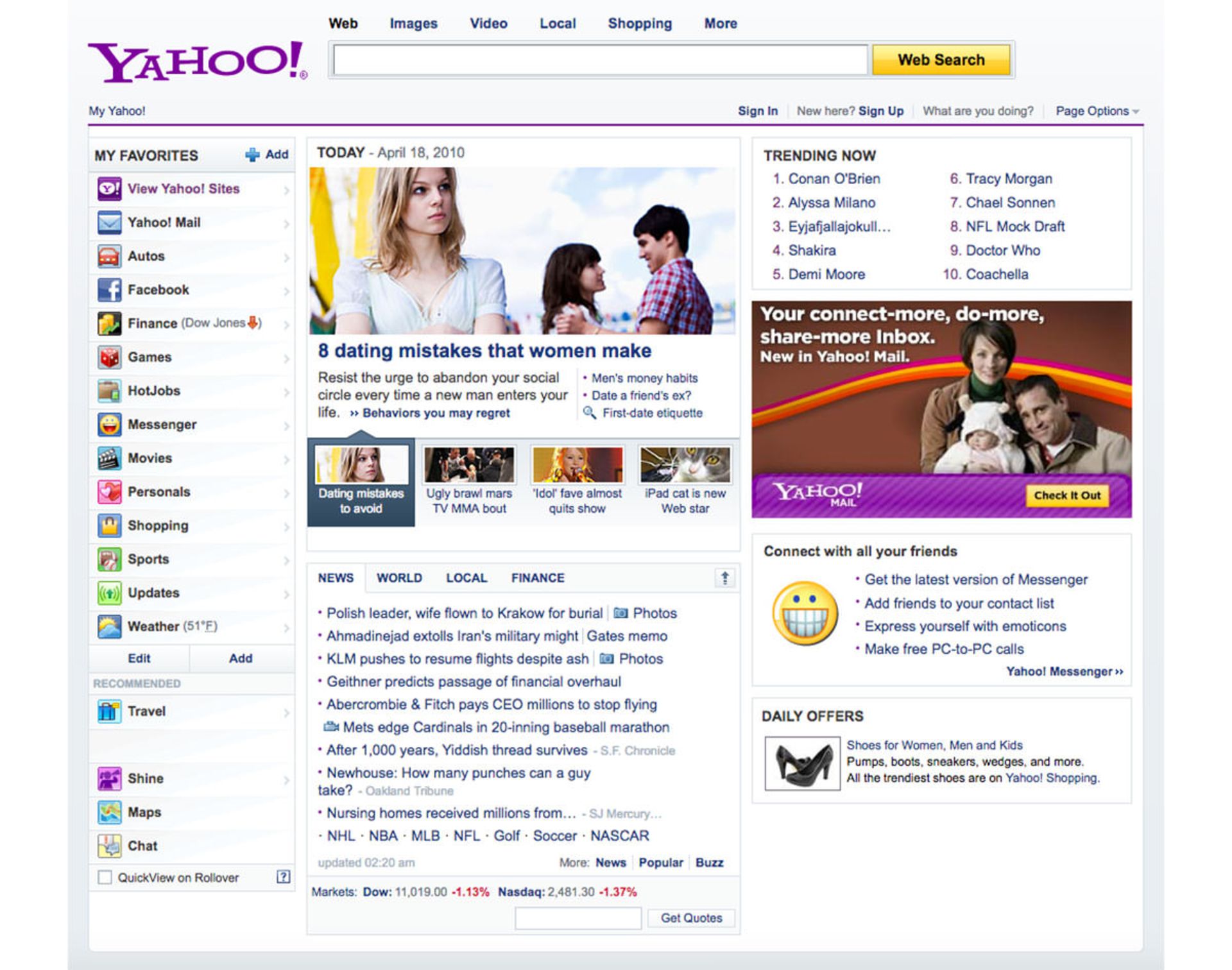
Yahoo Messenger, which experienced significant developments in all the years of ups and downs of the company and was trying to defeat its young competitors, was updated in 2011 with various capabilities. In fact, the last important update of the Windows version of this messenger was released in the same year, which had functions such as coordination with Facebook and Twitter.
Unsuccessful attempts
Scott Thomson briefly took over the management of Yahoo in 2012. He previously worked as a general manager at PayPal. As soon as Thomson’s administration began, rumors of a possible new staff adjustment at Yahoo began to grow. In April of that year, the news of the layoff of 2,000 people, equivalent to 14% of Yahoo’s workforce, was published.
During his tenure, Thomson made several attempts to reform Yahoo’s structure. He divided the company into three sub-categories to organize activities more. Of course, Thomson was not successful in the end and was replaced by the former CEO of Google, Marissa Mayer. Mayer joined Yahoo in 2012 as the youngest CEO of a Fortune 500 company.
Google intern, head of Yahoo
When Marissa Mayer joined Yahoo as CEO, hopes were revived to save the company from collapse. Even the ceremony of Mayer’s entry into Yahoo was held with a special theme and the slogan of hope was injected into the company.
In 1999, Marissa Mayer turned down great job opportunities to work as an intern at Google. Having an excellent academic background, he decided to draw his future in management in the world of technology. At Google, Mayer worked as the senior vice president of user experience and search engine for a while. Mayer’s excellent record at Yahoo’s biggest rival made it likely that he had the ability to save the company from collapse.
 Marissa Meyer
Marissa Meyer
Experts believe that the huge funds in the hands of Yahoo allowed the company to take risks on Marissa Mayer. Don’t forget that Yahoo was one of Alibaba’s early investors in 2005 and has always had a decent stream of income through the same stock. In fact, this same shareholding made Yahoo still have a high value as a company despite numerous product failures. However, Mayer was somewhat discouraged by the downgrade he received in Google and finally came to Yahoo.
Mayer’s management
When Marissa Mayer came to Yahoo, her employees admired her. Mayer first focused on improving Yahoo’s work environment and organizational culture. He tried to involve the employees as much as possible in the basic decision-making processes of the company and even personally participated in direct dialogue with them.
At the beginning of Mayer’s administration, the situation seemed good for Yahoo. In 2013, they won an award for their mobile weather app, and Mayer steered the company even further into mobile applications. A year after Mayer joined Yahoo, the company’s stock experienced a 60% increase, and they had the highest profit among Fortune 500 companies with a 75% gain.
 Yahoo in 2013
Yahoo in 2013
During Mayer’s management, Yahoo was able to overtake Google in the search engine business in a short period. They also managed to buy the social network Tumblr in competition with Facebook. Mayer, like the previous managers, had repeatedly entered the process of buying startups, and paying 1.1 billion dollars to buy Tumblr was one of his big actions. However, despite all the growth experienced until the mid-2010s, Yahoo was still in a period of crisis and far from its peak years. In addition, the employees’ hope and faith in the company had not yet been fully restored.
A big challenge for Yahoo
Alibaba’s IPO was an event that brought huge challenges to Yahoo. With a valuation of 230 billion dollars, the Chinese company became a giant in the world of e-commerce, which also brought a significant capital increase for Yahoo. Shareholders came to Mayer after Alibaba’s IPO and negotiated with him about the capital raised from Alibaba. They sought to determine how to spend the new capital and their share. Some experts suggested that Yahoo enter into a strategic alliance with AOL to reduce its tax challenges.
Alibaba’s IPO brought financial challenges for Yahoo
In 2015, Yahoo decided to spin off its stake in Alibaba into a separate company to ease pressure from tax authorities. As a result, Yahoo’s operational role at Alibaba was also reduced, and they separated their small business division (including websites) from the parent company. That same year, Verizon acquired AOL to expand its presence in video and mobile advertising. Subsequently, Yahoo’s plans to circumvent the tax system were not successful and the crisis of heavy tax rulings threatened the company. Finally, Alibaba’s stock split plans were canceled.
Tax evasion attempt
In 2016, it continued to explore options to stay out of the tax squeeze after making huge profits from Alibaba’s IPO. Yahoo entered into discussions with several banks to explore new options. One option was to sell the business entirely. Among the important investors who put pressure on Yahoo in this change of direction, we can mention Starboard Value, which was seriously looking at the sale of the company. Finally, Verizon’s plans to buy Yahoo were officially announced, which again caused the company’s stock to fall.
Chapter 4: Current Yahoo!
Yahoo had already lost to Google in 2016 and was also struggling with big challenges. As a result, Yahoo’s empire was on the decline in the 21st century. In this part of Yahoo’s story, we examine the state of this company in recent years.
Purchase offer
The news of Verizon’s serious and final decision to buy Yahoo’s Internet business core was announced in July 2016. The American company decided to merge its new $4.83 billion acquisition with AOL and launch a new company called Oath. As mentioned, this purchase did not include Alibaba’s 15% stake, and Yahoo Japan also continued to operate independently. The two mentioned departments later continued to work under the management of the new team under the name of Altaba. Oath Inc. also changed its name to Verizon Media in 2019.
 Verizon, the current owner of Yahoo!
Verizon, the current owner of Yahoo!
Disclosure of Yahoo users’ information
Among the important events surrounding Yahoo in 2016, we can mention the September news that confirmed the hacking of Yahoo and the disclosure of the information of 500 million users. The mentioned hacking happened in 2014 and some security experts considered Russian forces responsible for hacking Yahoo. Some time later, similar news was heard from Yahoo, which this time affected about three billion users and in a way put the final blows to Yahoo’s figure. This news caused Verizon to reduce its offer by $350 million. Finally, Yahoo was bought by Verizon in June 2017 in a deal worth $4.48 billion.
 Yahoo logo from 2013 to 2019
Yahoo logo from 2013 to 2019
Since 2017, when Yahoo and AOL have been operating under the ownership of Verizon, there have been minor incidents in their products and services. For example, in 2018, an application called Yahoo! Together was released for Android and iOS mobile platforms to meet the needs of traditional Yahoo Messenger and AOL Messenger users as a modern application. The said messenger was aimed at families and end consumers, and of course, in some cases it was known as a competitor of Slack. Finally, this messenger was closed in 2018.
Yahoo Japan, which was not involved in Verizon’s acquisition of Yahoo’s core business, went the opposite way from the parent company. This company, which was the result of cooperation between Yahoo and Softbank, has continued its activity after 2017 and uses the Yahoo brand after obtaining a license from Verizon. Yahoo Japan’s web portal has the title of the most visited website in this country, and its internet services are among the best. Yahoo Japan’s management center is located in Tokyo.

Complete liquidation of Yahoo!
Founded in New York as the remnants of Yahoo after the sale of the core business to Verizon, Altaba had no operational activities and only managed the company’s cash, investments, bond portfolio, and some remaining patents. The only part of the Yahoo brand that remained in Altaba was Yahoo Japan, which was completely transferred to Softbank in 2018. The company’s shares were also removed from the Nasdaq market on October 2, 2019. On the 4th of October, the process of liquidation and complete liquidation of the company was finalized and only a partial capital was left to pay the possible tax on the company’s assets from Alibaba shares.


You may like
-

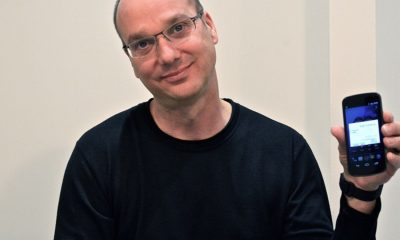


The biography of Andy Rubin, the creator of Android
-




How to prevent your location from being revealed through photos?
-

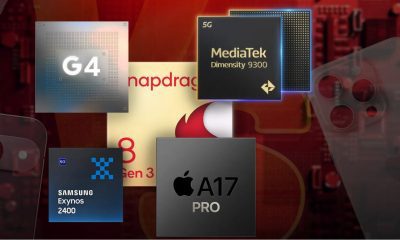


The chip battle of flagship phones in 2024; Which is the winner?
-

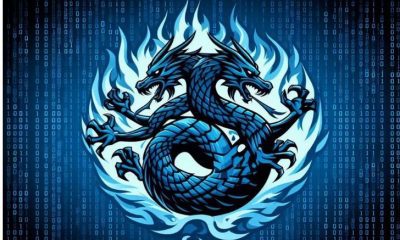


What is Kali Linux? Everything you need to know about this popular but mysterious distribution
-

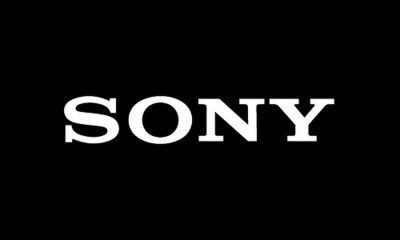


Sony Brand Story; From the production of rice cookers to becoming one of the most famous companies in the world
-




How did the people of the past imagine the future?


RobinNoun: Someone connected with any number of sports teams known as the , as a fan, player, coach, etc.
RobinNoun: Someone connected with any number of sports teams known as the , as a fan, player, coach, etc.
Noun: Someone connected with any number of sports teams known as the , as a fan, player, coach, etc.
Noun: Someone connected with any number of sports teams known as the , as a fan, player, coach, etc.
Noun: Someone connected with any number of sports teams known as the, as a fan, player, coach, etc.
Noun: Someone connected with any number of sports teams known as the, as a fan, player, coach, etc.
Noun: Someone connected with any number of sports teams known as the, as a fan, player, coach, etc.
Noun: Someone connected with any number of sports teams known as the , as a fan, player, coach, etc.
Noun: Someone connected with any number of sports teams known as the , as a fan, player, coach, etc.
Noun: Someone connected with any number of sports teams known as the , as a fan, player, coach, etc.
Noun: Someone connected with any number of sports teams known as the , as a fan, player, coach, etc.
Noun: Someone connected with any number of sports teams known as the , as a fan, player, coach, etc.
Noun: Someone connected with any number of sports teams known as the , as a fan, player, coach, etc.
Noun: Someone connected with any number of sports teams known as the , as a fan, player, coach, etc.
Noun: Someone connected with any number of sports teams known as the , as a fan, player, coach, etc.
Noun: Someone connected with any number of sports teams known as the , as a fan, player, coach, etc.
Noun: Someone connected with any number of sports teams known as the , as a fan, player, coach, etc.
Noun: Someone connected with any number of sports teams known as the , as a fan, player, coach, etc.
Noun: Someone connected with any number of sports teams known as the , as a fan, player, coach, etc.
Noun: Someone connected with any number of sports teams known as the , as a fan, player, coach, etc.
Noun: Someone connected with any number of sports teams known as the , as a fan, player, coach, etc.
Noun: Someone connected with any number of sports teams known as the , as a fan, player, coach, etc.
Noun: Someone connected with any number of sports teams known as the , as a fan, player, coach, etc.
Noun: Someone connected with any number of sports teams known as the , as a fan, player, coach, etc.
Noun: Someone connected with any number of sports teams known as the , as a fan, player, coach, etc.
Noun: Someone connected with any number of sports teams known as the , as a fan, player, coach, etc.
Noun: Someone connected with any number of sports teams known as the , as a fan, player, coach, etc.
Adverb: To such an extent or degree; to the same extent or degree.
Adverb: consider to be, in relation to something else; in the relation (specified).
Conjunction: In the (same) way or manner that; to the (same) degree that.
Conjunction: At the time that; during the time when:
Conjunction: Being that, considering that, because, since.
Conjunction: ; specifically.
Conjunction: than.
Preposition: In the role of.
Preposition: by way of
Noun: A libra.
Noun: Any of several coins of Rome, coined in bronze or later copper; or the equivalent value.
Adverb: ; very much; extremely
Noun: Someone connected with any number of sports teams known as the , as a fan, player, coach, etc.
Noun: Someone connected with any number of sports teams known as the , as a fan, player, coach, etc.
Noun: Someone connected with any number of sports teams known as the , as a fan, player, coach, etc.
Noun: Someone connected with any number of sports teams known as the , as a fan, player, coach, etc.
Noun: Someone connected with any number of sports teams known as the , as a fan, player, coach, etc.
Noun: Someone connected with any number of sports teams known as the , as a fan, player, coach, etc.
Noun: Someone connected with any number of sports teams known as the , as a fan, player, coach, etc.
Noun: Someone connected with any number of sports teams known as the , as a fan, player, coach, etc.
Noun: Someone connected with any number of sports teams known as the , as a fan, player, coach, etc.
Noun: Someone connected with any number of sports teams known as the , as a fan, player, coach, etc.
Noun: Someone connected with any number of sports teams known as the , as a fan, player, coach, etc.
Noun: Someone connected with any number of sports teams known as the , as a fan, player, coach, etc.
Noun: Someone connected with any number of sports teams known as the , as a fan, player, coach, etc.
Noun: Someone connected with any number of sports teams known as the , as a fan, player, coach, etc.
Noun: Someone connected with any number of sports teams known as the , as a fan, player, coach, etc.
Noun: Someone connected with any number of sports teams known as the , as a fan, player, coach, etc.
Noun: Someone connected with any number of sports teams known as the , as a fan, player, coach, etc.
Noun: Someone connected with any number of sports teams known as the , as a fan, player, coach, etc.
Noun: Someone connected with any number of sports teams known as the , as a fan, player, coach, etc.
Noun: Someone connected with any number of sports teams known as the , as a fan, player, coach, etc.
Noun: Someone connected with any number of sports teams known as the , as a fan, player, coach, etc.
Noun: Someone connected with any number of sports teams known as the , as a fan, player, coach, etc.
Noun: Someone connected with any number of sports teams known as the , as a fan, player, coach, etc.
Noun: Someone connected with any number of sports teams known as the , as a fan, player, coach, etc.
Noun: Someone connected with any number of sports teams known as the , as a fan, player, coach, etc.
Noun: Someone connected with any number of sports teams known as the , as a fan, player, coach, etc.
Noun: Someone connected with any number of sports teams known as the , as a fan, player, coach, etc.
Noun: Someone connected with any number of sports teams known as the , as a fan, player, coach, etc.
Noun: Someone connected with any number of sports teams known as the , as a fan, player, coach, etc.
Noun: Someone connected with any number of sports teams known as the , as a fan, player, coach, etc.
Noun: Someone connected with any number of sports teams known as the , as a fan, player, coach, etc.
Noun: Someone connected with any number of sports teams known as the , as a fan, player, coach, etc.
Noun: Someone connected with any number of sports teams known as the , as a fan, player, coach, etc.
Noun: Someone connected with any number of sports teams known as the , as a fan, player, coach, etc.
Noun: Someone connected with any number of sports teams known as the , as a fan, player, coach, etc.
Noun: Someone connected with any number of sports teams known as the , as a fan, player, coach, etc.
Noun: Someone connected with any number of sports teams known as the , as a fan, player, coach, etc.
RobinNoun: Someone connected with any number of sports teams known as the , as a fan, player, coach, etc.
Noun: Someone connected with any number of sports teams known as the , as a fan, player, coach, etc.
Noun: Someone connected with any number of sports teams known as the , as a fan, player, coach, etc.
Noun: Someone connected with any number of sports teams known as the , as a fan, player, coach, etc.
Noun: Someone connected with any number of sports teams known as the , as a fan, player, coach, etc.
Noun: Someone connected with any number of sports teams known as the , as a fan, player, coach, etc.
Noun: Someone connected with any number of sports teams known as the , as a fan, player, coach, etc.
Noun: Someone connected with any number of sports teams known as the , as a fan, player, coach, etc.
Noun: Someone connected with any number of sports teams known as the , as a fan, player, coach, etc.
Noun: Someone connected with any number of sports teams known as the , as a fan, player, coach, etc.
Noun: Someone connected with any number of sports teams known as the , as a fan, player, coach, etc.
Noun: Someone connected with any number of sports teams known as the , as a fan, player, coach, etc.
Noun: Someone connected with any number of sports teams known as the , as a fan, player, coach, etc.
Noun: Someone connected with any number of sports teams known as the , as a fan, player, coach, etc.
Noun: Someone connected with any number of sports teams known as the , as a fan, player, coach, etc.
Noun: Someone connected with any number of sports teams known as the , as a fan, player, coach, etc.
Noun: Someone connected with any number of sports teams known as the , as a fan, player, coach, etc.
Noun: Someone connected with any number of sports teams known as the , as a fan, player, coach, etc.
Noun: Someone connected with any number of sports teams known as the , as a fan, player, coach, etc.
Noun: Someone connected with any number of sports teams known as the , as a fan, player, coach, etc.
Noun: Someone connected with any number of sports teams known as the , as a fan, player, coach, etc.
Noun: Someone connected with any number of sports teams known as the , as a fan, player, coach, etc.
Noun: Someone connected with any number of sports teams known as the , as a fan, player, coach, etc.
Noun: Someone connected with any number of sports teams known as the , as a fan, player, coach, etc.
Noun: Someone connected with any number of sports teams known as the , as a fan, player, coach, etc.
Noun: Someone connected with any number of sports teams known as the , as a fan, player, coach, etc.
Noun: Someone connected with any number of sports teams known as the , as a fan, player, coach, etc.
Noun: Someone connected with any number of sports teams known as the , as a fan, player, coach, etc.
Noun: Someone connected with any number of sports teams known as the , as a fan, player, coach, etc.
Noun: Someone connected with any number of sports teams known as the , as a fan, player, coach, etc.
Noun: Someone connected with any number of sports teams known as the , as a fan, player, coach, etc.
Noun: Someone connected with any number of sports teams known as the , as a fan, player, coach, etc.
Noun: Someone connected with any number of sports teams known as the , as a fan, player, coach, etc.
Noun: Someone connected with any number of sports teams known as the , as a fan, player, coach, etc.
Noun: Someone connected with any number of sports teams known as the , as a fan, player, coach, etc.
Noun: Someone connected with any number of sports teams known as the , as a fan, player, coach, etc.
Noun: Someone connected with any number of sports teams known as the , as a fan, player, coach, etc.
Noun: Someone connected with any number of sports teams known as the , as a fan, player, coach, etc.
Noun: Someone connected with any number of sports teams known as the , as a fan, player, coach, etc.
Noun: Someone connected with any number of sports teams known as the , as a fan, player, coach, etc.
Noun: Someone connected with any number of sports teams known as the , as a fan, player, coach, etc.
Noun: Someone connected with any number of sports teams known as the , as a fan, player, coach, etc.
Noun: Someone connected with any number of sports teams known as the , as a fan, player, coach, etc.
Noun: Someone connected with any number of sports teams known as the , as a fan, player, coach, etc.
Noun: Someone connected with any number of sports teams known as the , as a fan, player, coach, etc.
Noun: Someone connected with any number of sports teams known as the , as a fan, player, coach, etc.
Noun: Someone connected with any number of sports teams known as the , as a fan, player, coach, etc.
Noun: Someone connected with any number of sports teams known as the , as a fan, player, coach, etc.
Noun: Someone connected with any number of sports teams known as the , as a fan, player, coach, etc.
Noun: Someone connected with any number of sports teams known as the , as a fan, player, coach, etc.
Adverb: To such an extent or degree; to the same extent or degree.
Adverb: consider to be, in relation to something else; in the relation (specified).
Conjunction: In the (same) way or manner that; to the (same) degree that.
Conjunction: At the time that; during the time when:
Conjunction: Being that, considering that, because, since.
Conjunction: ; specifically.
Conjunction: than.
Preposition: In the role of.
Preposition: by way of
Noun: A libra.
Noun: Any of several coins of Rome, coined in bronze or later copper; or the equivalent value.
Adverb: ; very much; extremely
Noun: Someone connected with any number of sports teams known as the , as a fan, player, coach, etc.
Noun: Someone connected with any number of sports teams known as the , as a fan, player, coach, etc.
Noun: Someone connected with any number of sports teams known as the , as a fan, player, coach, etc.
Noun: Someone connected with any number of sports teams known as the , as a fan, player, coach, etc.
Noun: Someone connected with any number of sports teams known as the , as a fan, player, coach, etc.
Noun: Someone connected with any number of sports teams known as the , as a fan, player, coach, etc.
Noun: Someone connected with any number of sports teams known as the , as a fan, player, coach, etc.
Noun: Someone connected with any number of sports teams known as the , as a fan, player, coach, etc.
Noun: Someone connected with any number of sports teams known as the , as a fan, player, coach, etc.
Noun: Someone connected with any number of sports teams known as the , as a fan, player, coach, etc.
Noun: Someone connected with any number of sports teams known as the , as a fan, player, coach, etc.
Noun: Someone connected with any number of sports teams known as the , as a fan, player, coach, etc.
Noun: Someone connected with any number of sports teams known as the , as a fan, player, coach, etc.
Noun: Someone connected with any number of sports teams known as the , as a fan, player, coach, etc.
Noun: Someone connected with any number of sports teams known as the , as a fan, player, coach, etc.
Noun: Someone connected with any number of sports teams known as the , as a fan, player, coach, etc.
Noun: Someone connected with any number of sports teams known as the , as a fan, player, coach, etc.
Noun: Someone connected with any number of sports teams known as the , as a fan, player, coach, etc.
Noun: Someone connected with any number of sports teams known as the , as a fan, player, coach, etc.
Noun: Someone connected with any number of sports teams known as the , as a fan, player, coach, etc.
Noun: Someone connected with any number of sports teams known as the , as a fan, player, coach, etc.
Noun: Someone connected with any number of sports teams known as the , as a fan, player, coach, etc.
Noun: Someone connected with any number of sports teams known as the , as a fan, player, coach, etc.
Noun: Someone connected with any number of sports teams known as the , as a fan, player, coach, etc.
Noun: Someone connected with any number of sports teams known as the , as a fan, player, coach, etc.
Noun: Someone connected with any number of sports teams known as the , as a fan, player, coach, etc.
Noun: Someone connected with any number of sports teams known as the , as a fan, player, coach, etc.
Noun: Someone connected with any number of sports teams known as the , as a fan, player, coach, etc.
Noun: Someone connected with any number of sports teams known as the , as a fan, player, coach, etc.
Noun: Someone connected with any number of sports teams known as the , as a fan, player, coach, etc.
Noun: Someone connected with any number of sports teams known as the , as a fan, player, coach, etc.
Noun: Someone connected with any number of sports teams known as the , as a fan, player, coach, etc.
Noun: Someone connected with any number of sports teams known as the , as a fan, player, coach, etc.
Noun: Someone connected with any number of sports teams known as the , as a fan, player, coach, etc.
Noun: Someone connected with any number of sports teams known as the , as a fan, player, coach, etc.
Noun: Someone connected with any number of sports teams known as the , as a fan, player, coach, etc.
Noun: Someone connected with any number of sports teams known as the , as a fan, player, coach, etc.
The biography of Andy Rubin, the creator of Android
Andy Rubin (Andy Rubin) with the correct pronunciation of Andy Rubin, is a programmer and entrepreneur from the United States, who is best known for his work in founding Android. Before creating the popular mobile operating system, he had worked in many companies for many years and finally, his idea and plan were supported by Google. An idea that has become the most popular mobile operating system in the world today. Rubin left Google after a few years and decided to start his own business and invest in startups. Of course, none of his subsequent activities were as big as Android.
People who have worked with Rubin consider him a genius with technical knowledge. An engineer who understands the subtleties of management and entrepreneurship and has dynamic leadership. Android was Andy Rubin’s nickname during his years at Apple. This term, which was generally used for robots, was given to Rubin because of his strong interest in these human-made creatures. Rubin has always been interested in making, be it coding or building robots. When Rubin was developing his mobile operating system, he was trying to create a competitor to Symbian, Blackberry, and Microsoft Windows Mobile. An effort that came to fruition and finally turned Android into the main competitor of Apple’s iOS. The competition between Google and Apple reached its peak since then, and the late Steve Jobs sent harsh comments to Rubin and his mobile operating system.
In the years of working at Google and managing the Android sub-category, Andy Rubin made the foundations of the operating system he built so strong that the development in the coming years went quickly; The result of an ethical case became the point of Rubin‘s credit at Google. He was forced to leave the company due to the lawsuit and scandal, despite the secrecy of Google managers. Rubin‘s departure from Google was accompanied by a lot of controversy and media hype, and he sent severe criticism to Mountain View executives, who had even rewarded him. However, after leaving Google, Rubin focused on investing in the business ecosystem. He also started a smartphone manufacturing company, Essential, which was announced in the media recently.

Early years and entering the business world
Andy Rubin (full name Andrew E. Rubin) was born in 1963 in Chappaqua, New York. Since childhood, he lived in a world full of gadgets. His father’s company was active in the field of industrial photography, and Andy was introduced to attractive images of smart industrial products from childhood. He completed his high school education at Horace Greeley School in his hometown, and during high school, he did his first serious robotics activities. Rubin designed a remote control for the Kenner R2-D2 toy and moved it around the house with computer control.
Rubin‘s talent and interest in the computer world were evident from childhood and adolescence. For this reason, he chose the field of computer science at university and completed his higher education in 1986 at Utica College in New York. As we said, robots were an important part of Rubin‘s interests. On the other hand, due to the development of a social network-like survey called Spies at the University (1981), Rubin took pride in creating the concept of a social network 23 years before Facebook. From a young age, he focused on the development of products and technologies in this field and chose his first job related to his interest.
Carl Zeiss was Andy Rubin‘s first workplace. He was employed as a robotics engineer in a German company and worked there for two years. The next destination of the American engineer was again Europe. After Carl Zeiss, Andy went to the SIP Institute in Geneva, Switzerland.

Andy Rubin‘s popular toy that became an Android icon
Andy Rubin‘s serious entry into the world of technology took place with a company that later became his serious competitor. Andy Rubin met Bill Caswell during a summer vacation in the Cayman Islands. Their relationship became more serious and Bey offered Andy a job at Apple. This offer became an excuse for Rubin to pursue his life path more seriously in the world of technology.
By the time Andy Rubin joined Apple, they were in good shape. Mackintosh’s popularity had reached its peak, But Steve Jobs was not present in the company he founded. However, Rubin gained a lot of experience while working at Apple and was one of the most popular employees. The nickname Android was given to him by a colleague in the same years to show that Andy has a great interest in robots.
Andy Rubin‘s love for building and especially developing robots sprouted from childhood
Andy Rubin first worked as a manufacturing engineer at Apple; But after a while, he went to the research and development department. In 1990, they launched a spin-off company called General Magic, where Rubin continued to work. General Magic was launched as a company focused on handheld and mobile devices so that Apple could focus its activities on the same PC ecosystem. General Magic engineers, in collaboration with Andy Rubin, developed a software called Magic Cap, which, of course, was not very successful. Finally, General Magic was closed in 1995.
The closure of General Magic meant the end of Rubin‘s cooperation with Apple. He started a new company called Artemis Research together with some of his colleagues in the mentioned company and some of the former employees of Apple. They developed a product called WebTV, which was designed to combine the worlds of the Internet and television. The Artemis company finally became an excuse for Rubin to continue his work in another giant of the technology world: Microsoft. The Redmondis welcomed the Artemis product and bought the company, and Rubin continued his work at Microsoft. One of Rubin‘s interesting projects at Microsoft was the creation of a robot equipped with a camera, which was done with the sole purpose of attracting the attention of colleagues. Rubin eventually left Microsoft and WebTV in 1999.

After leaving Microsoft, Andy Rubin decided to work independently. He rented space in Palo Alto and continued his research and hardware and software experiments there. His office was full of robots that he designed and produced for research development and testing. The same environment somehow inspired Rubin to do something new.
Danger Inc. was the brainchild of Andy Rubin, who started working with his old friends Matt Hershensen and Joe Britt in 1999. The name of the company was taken from a robot from the movie Lost in Space. Rubin became the CEO of the company; A company that was launched with the aim of designing and developing hardware, software, and services for mobile processing devices. The success of Rubin‘s new company was notable with a device called the Danger Sidekick. This device, which was first developed as Danger Hiptop, was finally marketed as T-Mobile Sidekick. Rubin said about the mentioned device: “We wanted a device that would be the size of a chocolate bar and come to the market at a price of less than 10 dollars. We wanted this device to have the ability to scan objects and receive information about them from the Internet. A device that acted like an intelligent assistant.
Rubin‘s new company was a center of genius engineers and designers who produced a product ahead of its time. However, they could not market their idea well and other companies were not willing to cooperate with Danger. Ultimately, Andy Rubin kept his faith in his new idea and company alive until Microsoft bought the company in 2008.
The ideas and experiences that Andy Rubin had gained from the Danger Company led to the development of a revolutionary idea in his mind. He nurtured his many ideas to create Android. An idea whose name was taken from the same nickname of Andy Rubin‘s distant years. It is interesting to know that the Android.com website was Andy Rubin‘s personal website until 2008.
 One of the few devices equipped with Magic Cap
One of the few devices equipped with Magic Cap
Creating Android and joining Google
Andy Rubin founded Android, Inc. in October 2003. His early colleagues were Rich Miner (co-founder of Wildfire Communications), Nick Sears (former SVP of T-Mobile), and Chris White (WebTV user interface designer and developer). Andy Rubin needed investors to develop and develop the idea of Android and cooperated with Redpoint Ventures. His initial idea was to create a powerful mobile platform that would be open source and lead to faster innovation and multiple benefits for the customer.
Android company first decided to develop an operating system for cameras. Of course, the digital camera market was not big enough to guarantee the financial return of Andy Rubin‘s idea; That’s why he and his colleagues decided to develop the operating system for smartphones. They wanted to be a competitor to the giants of the market at that time, Symbian, Blackberry OS, and Windows Mobile. In the early stages of Android development, Rubin proposed interesting concepts for its users. For example, he believed that people need smarter mobile phones that are more aware of the owner’s priorities and position.
Android was the nickname of Andy Rubin at Apple and he used the same name for the open-source mobile operating system
In the early years, Android worked quietly and without attracting attention. They only introduced themselves as a company focused on mobile software development. The quiet activity came with financial challenges for Rubin and his company. He could not manage the available resources well and even after some time, he could not afford to pay for the office of the company.
Andy finally called his friend Steve Perlman and explained the startup’s challenges. Although Rubin did not directly ask for investment and funding in his conversation with Perelman; Steve promised to inject new capital into the company. Perlman donated $10,000 from his personal account to the Android company. About his action, he says that he trusted Andy’s idea and decided to help him. Perlman later did not ask for any shares from Android. Andy Rubin, by receiving cash help from his friend, returned the development process of Android to the normal routine. He used the new capital to expand the team and leased a larger office in Palo Alto.
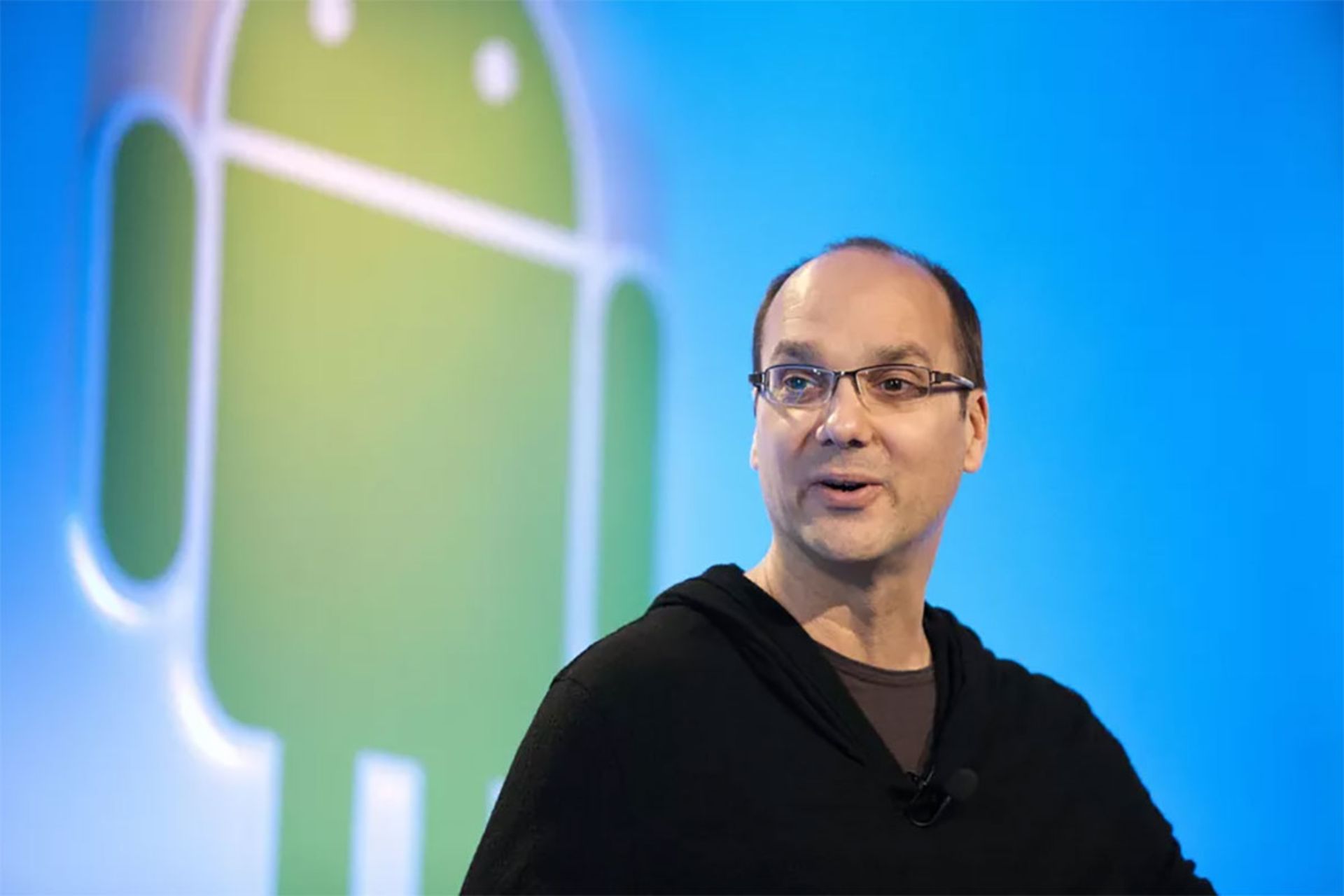 Andy Rabil at the launch of Android
Andy Rabil at the launch of Android
Google executives’ familiarity with Andy Rubin goes back to a lecture at Stanford University. A university that has been the place of study for many great people in the current world of technology and plays an important role in the development of Silicon Valley. In 2002, Andy Rubin gave a talk about the Sidekick device at Stanford, which was attended by Larry Pitch and Sergey Brin. Later, in a private meeting with Rubin, Page had seen his device up close and admired the idea even more for using the Google search engine in it.
Larry Page’s relationship with Andy Rubin deepened in the following years. Page imagined a bright future for Android from the very beginning, while Sergey Brin and Eric Schmidt (then CEO of Google) distanced themselves from the idea and considered themselves far from the mobile world. However, Page became fascinated with the idea of an open-source mobile operating system and the prospect of global development managed by Google fascinated him more. He believed that Android is one of the most suitable ideas for Google. Page also had the idea of a Google smartphone in mind and tried his best to bring Android to Mountain View. At first, Rubin was hesitant to join Google and did not consider the organizational culture to be a good fit.
Andy Rubin has been instrumental in many of the technology industry’s historic innovations. During the same years of Android development, he also made serious investments and in 2004, he contributed $100,000 to Sebastian Theron’s project to develop a self-driving car. Theron won the Darpa Grand Challenge with Rubin‘s help and later worked as the manager of Google’s self-driving car division.
Page’s efforts to recruit Andy Robin and the Android team finally came to fruition in 2005. They acquired Android by paying about 50 million dollars. The main team members, including Andy Rubin, joined the new company. The interesting thing is that at that time and even until some time later, no one knew why Google should buy a mobile operating system. Even now, much of the narrative surrounding Google’s original intentions is speculation. However, Android is still known as a mobile software development company, and most thought that Google was planning to enter the mobile market.

Andy Rubin started working at Google as the senior vice president of a new team called Android. He managed a team of eight people responsible for the development of a mobile platform based on the Linux kernel. Google was also committed to marketing processes for Android as a platform for mobile devices. They started their cooperation with numerous software and hardware companies and the news of the development of the operating system was also announced to mobile operators.
Andy Rubin‘s tenure at Google was accompanied by the management and development of numerous projects. He helped form the Android Update Alliance, which coordinated the release of updates between carriers. Other positive activities of Rubin at Google include supporting and managing the purchase of Motorola.
Apple and Google war
In 2007, Apple introduced the iPhone, which entered the mobile world as a revolutionary product. At that time, Google was still developing its mobile operating system, Android. When Steve Jobs showed the iPhone on stage with his usual marketing skills, Andy Rubin realized that he had to completely redesign his ideas for the launch of the operating system.
Andy Rubin was watching the iPhone launch event via the Internet while riding in a taxi. When Steve Jobs was showing his company’s new smartphone to the audience, Andy asked the driver to stop the car. Surprised by the introduction of the Apple device, he came to the conclusion that he should not introduce the desired phone. Apple was carrying out the development and design plans for its new phone with appropriate news coverage. In fact, most Google engineers were aware of the plans of Steve Jobs and his team; But none of them imagined that a competitor would introduce and offer a product of this quality.
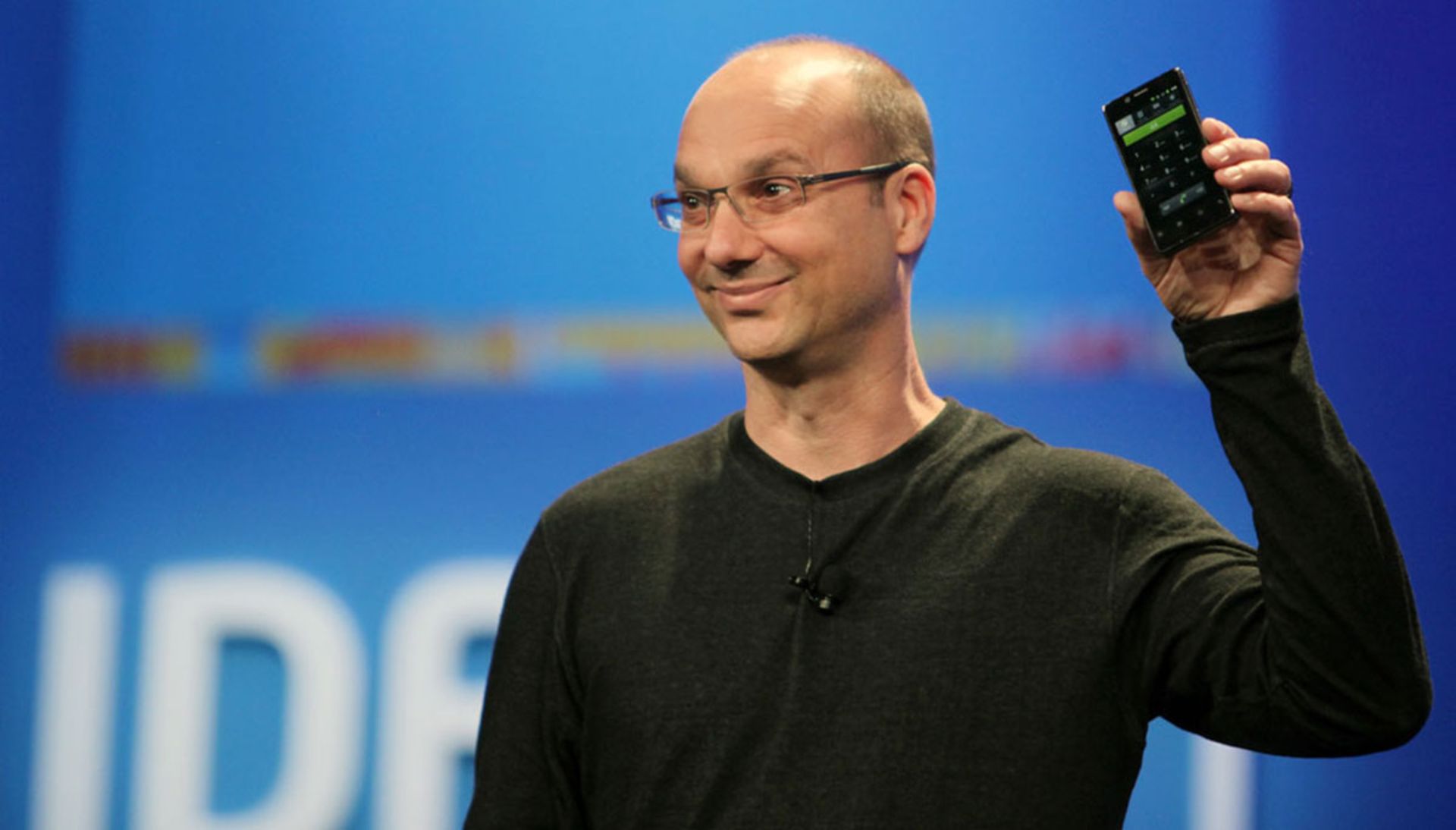
Rubin‘s smartphone display style looks similar to Steve Jobs
Google decided to introduce the mobile operating system by the end of 2007. After the iPhone was announced, they decided to postpone the launch schedule; Because Android had many similarities with the iPhone operating system. In fact, the introduction of the iPhone gave a strong blow to the entire Android project. In addition to the similarity of the operating system to iOS, Google engineers faced a more serious problem, which is the same high quality as the iPhone. A quality that made their achievement look like old technology. Even one of the Android engineers said that the initial design of the operating system was really inappropriate and weak compared to the iPhone, and in comparison, it looked like a product from the 1990s.
The Android team continued the development of the operating system despite the hard blow it received from Apple. Finally, in cooperation with HTC, they launched the first Android smartphone called HTC G1 or HTC Dream in 2008. The software on that phone was nowhere near as good as iOS on the iPhone, But it seemed so similar to Apple’s achievement that it brought anger and a strong reaction from Steve Jobs. In a sharp comment, he said that all parts of Android are disgusting imitations of their work.
Steve Jobs accused Andy Rubin of copying all parts of the iOS
Before the public release of Android, Steve Jobs had a good relationship with the main managers of Google. He trusted Larry Page Sergey Brin and Eric Schmidt. Even Eric Schmidt, along with the executive management of Google, was also a member of Apple’s board of directors. These three people had informed Jobs about Android development and promised him that the final product would be different from iOS. However, Jobs trusted them until the first Android-equipped smartphone hit the market.
After Jobs saw and experienced Android closely, he seriously asked Google managers to change its design. He arranged an important meeting with the iPhone’s chief software designer, Scott Forstall, in which Larry Page Andy Rubin , and Alan Eustis, Google’s senior vice president of engineering, were also present; A historical meeting that proceeded in a worrying manner. One of Apple’s executives, who was later informed by Jobs about the content of the meeting, said about it: “The meeting went completely towards personal problems. Jobs said that Rubin got very angry and told him that he had an anti-innovation approach. Then Steve had spoken angrily to Andy. He accused Andy of trying to be like him and even imitating his style of dressing and glasses.
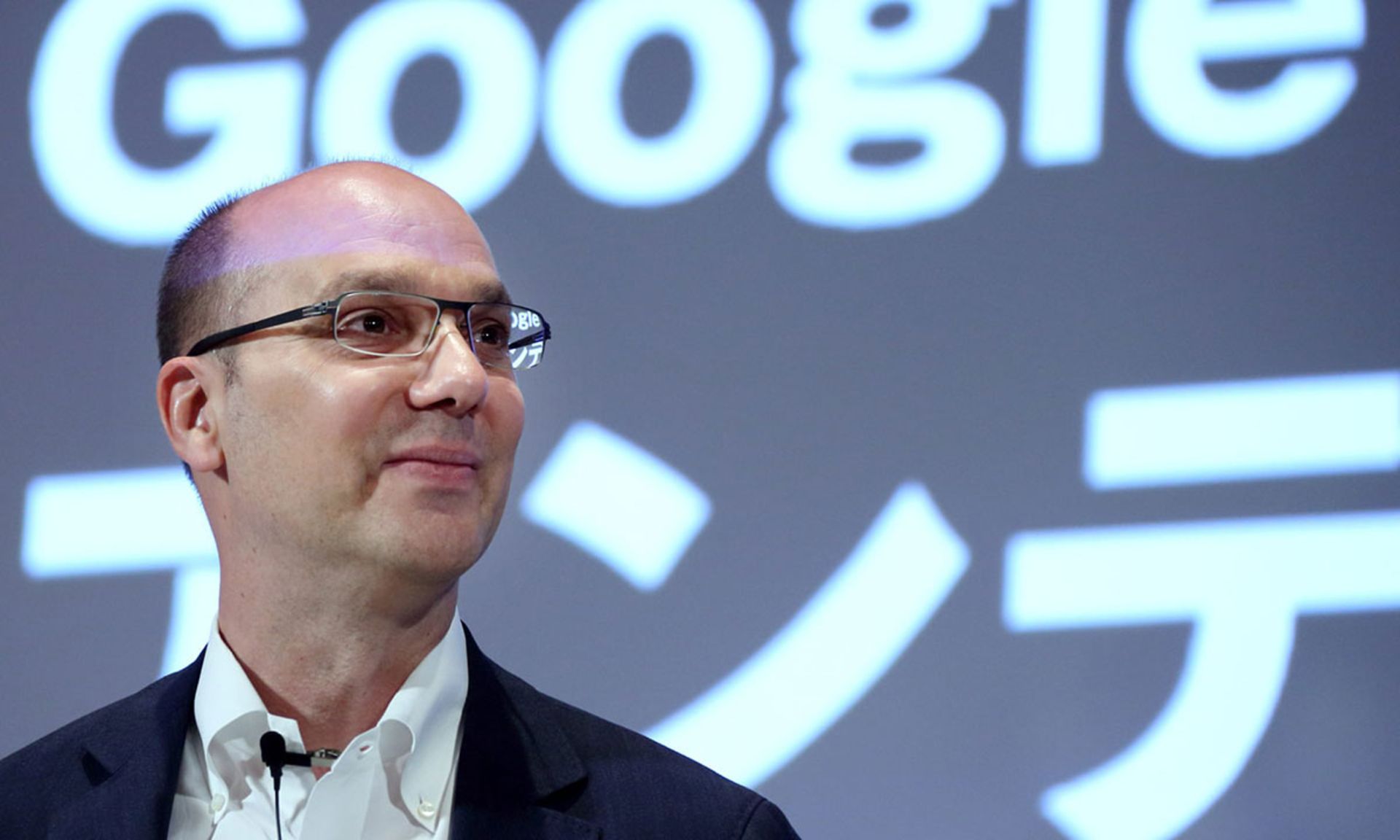
The historic meeting between Apple and Google was beneficial for Apple despite all the hatred and animosity it created between Jobs and Rubin. Android engineers were forced to change and even remove parts that were very similar to iOS. For example, the multi-touch function that was present in the iPhone was removed from Android. Meanwhile, Rubin was very angry with Jobs. After the historic meeting, he wrote on a board in his office: “STEVE JOBS STOLE MY LUNCH MONEY”.
Rubin was so angry with Jobs that he even decided to leave Google. Andy believed that many of the capabilities that Apple claims to have invented are not actually theirs. However, Android gradually added more features to the operating system, and Rubin also forgot to the leave Google program. After five years, the number of his team members had increased from eight to 250 people.
The controversial story of leaving Google
Andy Rubin left Google in 2014. The path that led to Rubin ‘s separation from Mountain View was a tortuous one, with many crises for both parties. When Rubin was leaving Google, the executives gave him extended appreciation and presented Rubin as a hero. Larry Page, CEO of Google at the time, said about Andy Rubin: “I wish Andy a bright and great future. He had a really big achievement with Android, which now has more than a billion satisfied and happy users.
The process of Andy Rubin ‘s separation from Google began in 2013. Larry Page announced in a blog post in March that Rubin would be moving from managing the Android team to managing a new project at Google. Rubin was replaced by Sundar Pichai, who is currently serving as the company’s CEO. After Android, Rubin went to Google’s robotics department to continue his work in his main field of interest. He was very happy and excited to manage the robotics department and described the new situation as ideal in various interviews. Finally, Andy Rubin left Google in 2014 and started a hardware startup incubator. We will continue the story of his life after leaving Google in the next section.
What was not initially told to the media in the story of Rubin ‘s separation was the illicit relationship of the Google hero with one of the employees, the consequences of which affected the entire company. The former Google employee even accused Rubin of sexual harassment. Google investigated his claims and confirmed their accuracy. Two Google executives made this story public in interviews with the media and said that Pitch asked Andy to resign after learning about the matter. Google could have fired Rubin without paying any benefits. Instead, they paid him a $90 million bonus. Also, the company committed to pay two million dollars to Rubin every month for four years.
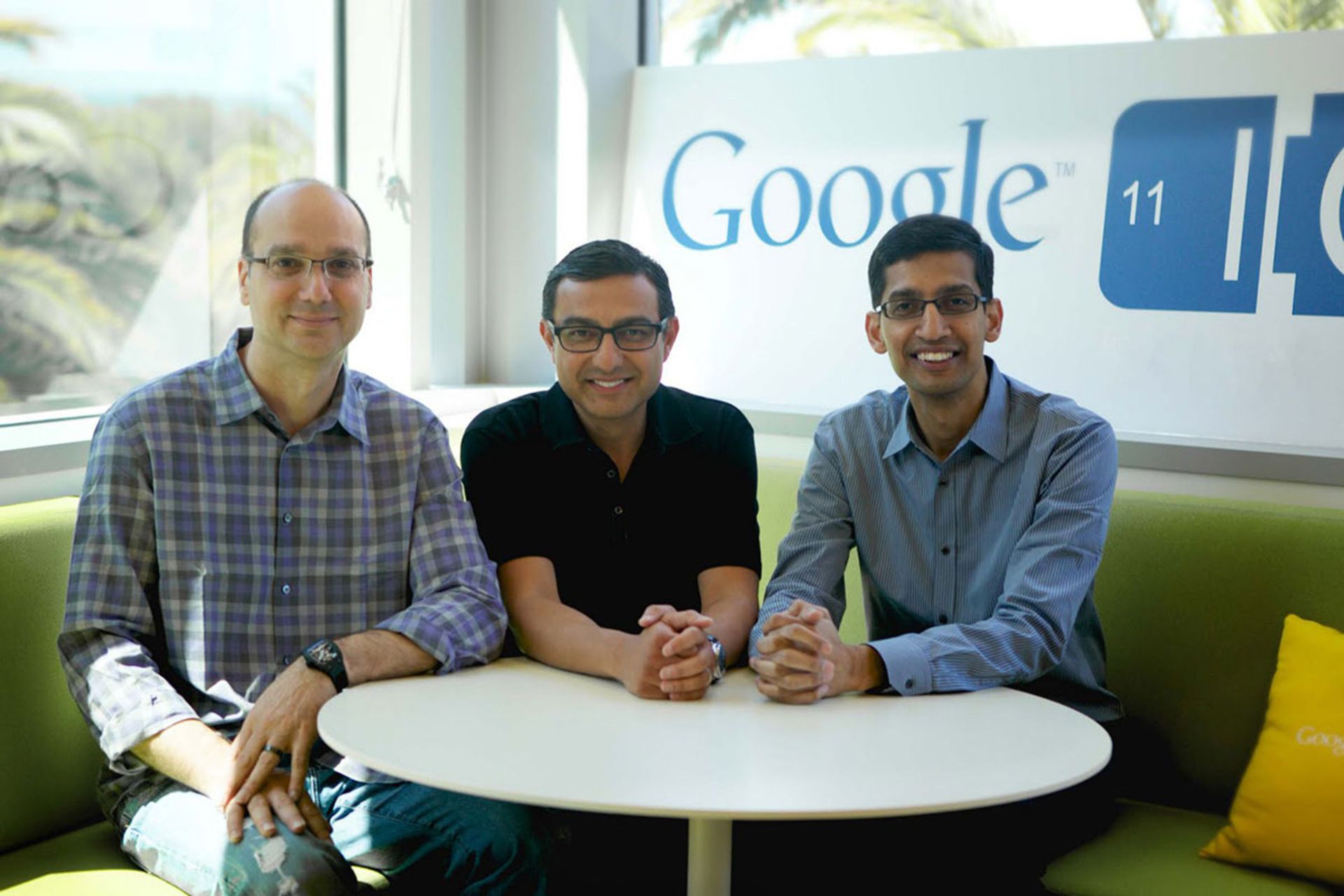 Along with Vic Gandotra and Sundar Pichai
Along with Vic Gandotra and Sundar Pichai
Google’s action in support of Andy Rubin was a repeated action. They had previously supported two other male managers in a similar process and even paid allowances after they left the company. The same decisions and actions of senior managers later turned into serious challenges for the people of Mountain View, and many employees described the Google environment as suitable and even encouraging for sexually harassing managers.
Many international media analyzed and analyzed the case of his accusation and Google’s support for years after Rubin‘s separation. Numerous reports from the media such as the New York Times focused the attention of people and company employees on a deep-rooted problem at Google. The media pressure was such that Sundar Pichai later sent a message to employees as CEO, claiming 48 managers and employees were fired for sexual allegations. However, current and former Google employees believed that the company’s actions were not enough.
In the media stream that arose after Rubin‘s departure from Google, many of his colleagues and former managers began to talk about the negative parts of his personality. On the other hand, Rubin was the one who brought Google services from the limited environment of the desktop to the devices that were seen in the hands of billions of users. Rubin, with all his problems, was still Google’s hero in the mobile world. On the other hand, managers who worked with him say that Rubin even humiliated his subordinates in various incidents. Naturally, Rubin and his representative deny this claim.
Investment and independent activity again
Regardless of the reasons and consequences of Rubin‘s departure from Google, he returned to his favorite path, namely designing and creating new concepts. Working in Google’s robotics department did not meet Rubin‘s mental needs. He had solved a big problem, the world of smartphones, and he needed a new problem. Two years after Rubin‘s departure, Wired published an interesting article about his new ideas, excerpts from which we quote.
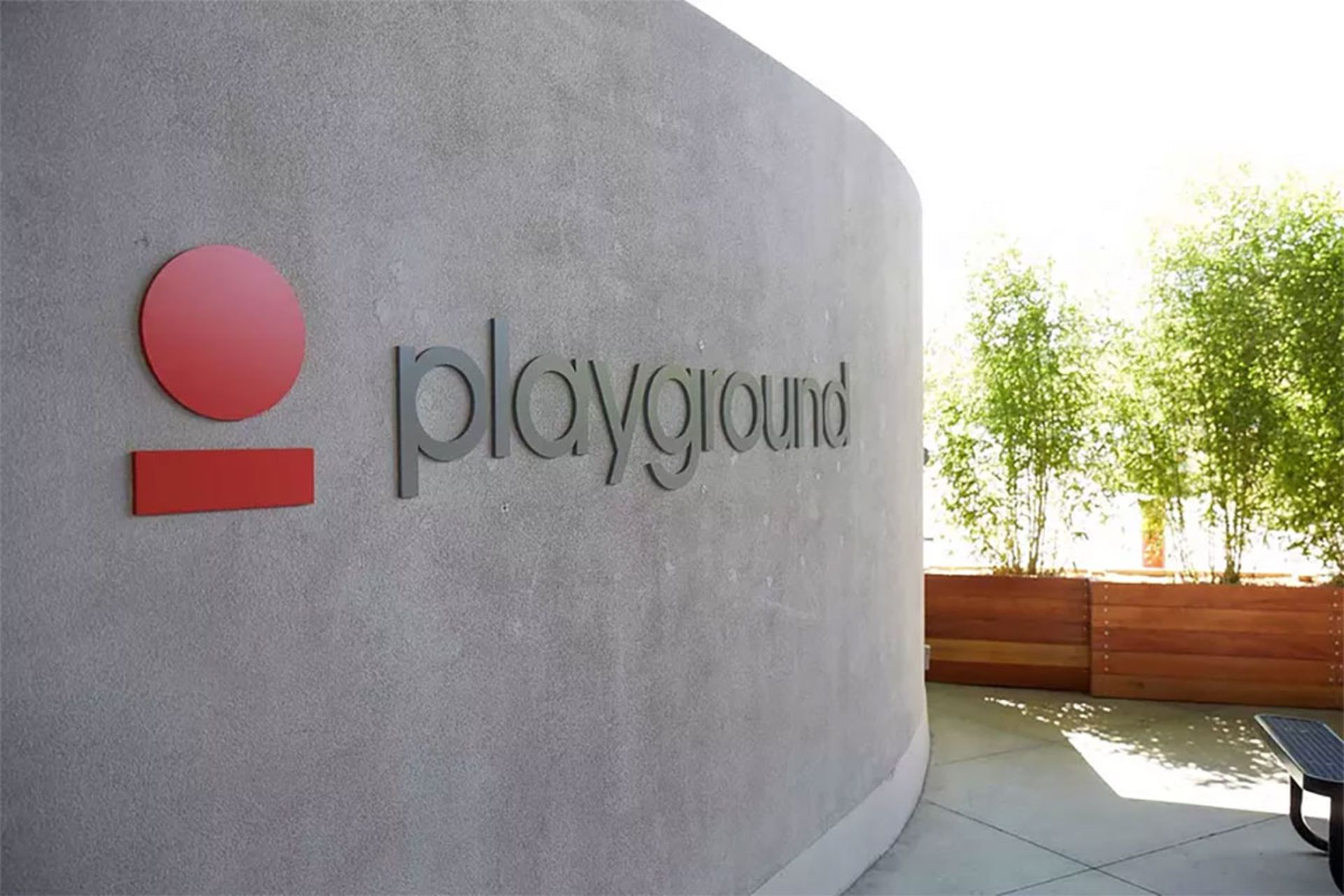
Andy Rubin launched Playground Global a few months after leaving Google; A company that, according to Rubin, was a new type of company; A combination that combined the concepts of incubator and consulting company; But none of them were. At the new company, Andy Rubin supported hardware startups. He did not, of course, limit his support to grants or advice, and provided them with a centralized engineering department. A department consisting of experienced and professional engineers who all worked with Rubin at Google, General Magic, Apple, and other companies. The engineering team worked closely with young and disruptive startup groups to develop hardware and software to power smart machines.
Rubin‘s vision for Polygrand Global was huge. He didn’t want his company to be limited to making a few products or even nurturing a few companies. Rubin and his colleagues envisioned a future focused on artificial intelligence and attempted to build the foundation of technology development through sponsored companies; Foundations that are freely available to others and eventually lead to the development of an ecosystem like Android. His new company was the booster of the idea; A structure that transformed basic concepts and ideas into products with maximum impact on the surrounding world. Playgrand was Rubin‘s first company in which there was no mention of robots (after Danger and Android), But they had a serious development in mind.
Essential was the last serious activity of Andy Rubin, which was closed in 2020
In 2015, Rubin‘s new company was able to receive 300 million in investments from Google, HP, Foxconn, Redpoint, Seagate, and Tencent. The attracted capital was spent on several projects, the most important of which is Owl Labs. Rubin finally left Polygrand in 2019.
Essential Products was Andy Rubin ‘s next entrepreneurial achievement. He decided to try his luck again in the world of mobiles and peripherals and in 2015, he launched the company. The Essential Phone and its accessories such as the 360-degree camera were one of the main products of the company. Rubin claimed that the Essential Phone will offer users a pure Android experience and will have the fastest software updates. Essential Phone was launched in 2017 and was well received by those interested in the Android ecosystem. Andy Rubin‘s lawsuit and scandal in 2017 caused him to leave Essential Management for a few months. Finally, the Palo Alto-based company announced in 2020 that it would no longer be operating.
 Essential Phone
Essential Phone
Personal life of Andy Rubin
In the story of Andy Rubin‘s departure from Google, we mentioned aspects of his personal life. Misbehavior with employees and leaked documents of Rubin ‘s sexual misconduct have tarnished his reputation alarmingly. She was married to Rei Hirabaru, but they divorced after a series of scandals and lawsuits. They had a coffee shop in Los Altos, California that closed in 2018.
Rubin and his ex-wife lived in a house in Woodside, California, which they bought in 2014 for $23 million. That house was also sold in 2018 during the separation, But now Rubin lives in it. Apparently, he is now known only as a Redpoint Ventures company in terms of employment.
In the story of Rubin ‘s life, there is always a trace of robots. In the years he was active at Google, in addition to managing the Android team, he spent his leisure time designing and developing robots. Rubin had designed several robotic arms for tasks such as preparing coffee. He also had a remote-controlled helicopter that he flew around Google’s yard.
Andy Rubin is known today for a legendary achievement called Android; An operating system that was born with the aim of developing the open-source concept in the mobile world and was seen in all smart devices from cars to home assistants and even televisions. Rubin‘s personal life has somewhat eroded his credibility in various tech circles; But it still has a place next to the greats like Jobs, Torvalds, Gates, and others.
Technology
How to prevent your location from being revealed through photos?
Published
1 day agoon
18/09/2024

Noun: tonne.
Noun: A particular point or place in physical space.
Noun: An act of locate.
Noun: An apartheid-era urban area populated by non-white people; township.
Noun: A lease on rent.
Noun: An Institute of the Law of Scotland</ref>
Noun: An administrative region in Kenya, below county and subcounty, and further divided into sublocations.
Noun: A particular point or place in physical space.
Noun: An act of locate.
Noun: An apartheid-era urban area populated by non-white people; township.
Noun: A lease on rent.
Noun: An Institute of the Law of Scotland</ref>
Noun: An administrative region in Kenya, below county and subcounty, and further divided into sublocations.
Noun: A particular point or place in physical space.
Noun: An act of locate.
Noun: An apartheid-era urban area populated by non-white people; township.
Noun: A lease on rent.
Noun: An Institute of the Law of Scotland</ref>
Noun: An administrative region in Kenya, below county and subcounty, and further divided into sublocations.
Adjective: happen; ; being or due to be put into action.
Adjective: Fitted; covering or being worn.
Adjective: Of a stated part of something, oriented towards the viewer or other specified direction.
Adjective: Acceptable, appropriate.
Adjective: Possible; capable of being successfully carried out.
Adjective: destined; involved, doomed.
Adjective: Having reached a base as a runner and being positioned there, awaiting further action from a subsequent batter.
Adjective: Within the half of the field on the same side as the batsman’s legs; the left side for a right-handed batsman.
Adjective: Of a ball, being the next in sequence to be potted, according to the rules of the game.
Adjective: Acting in character.
Adjective: Performative or funny in a wearying manner.
Adverb: To an operate state.
Adverb: So as to cover or be fitted.
Adverb: Along, forwards (continuing an action).
Adverb: In continuation, at length.
Adverb: later.
Adverb: See also ‘odds-on’.
Preposition: Positioned at the upper surface of, touching from above.
Preposition: Positioned at or resting against the outer surface of; attached to.
Preposition: At or in (a certain region or location).
Preposition: Near; adjacent to; alongside; just off.
Preposition: support by (the specified part of itself).
Preposition: Aboard (a mode of transport, especially public transport, or transport that one sits astride or uses while standing).
Preposition: At the date or day of.
Preposition: At a given time after the start of something; at.
Preposition: deal with the subject of; about; concerning.
Preposition: In the possession of.
Preposition: Because of; due to; upon the basis of (something not yet confirmed as true).
Preposition: At the time of (and often because of).
Preposition: Arrived or coming into the presence of.
Preposition: Toward; for; .
Preposition: Engaged in or occupied with (an action or activity).
Preposition: Regularly taking (a drug).
Preposition: Under the influence of (a drug, or something that is causing drug-like effects).
Preposition: In addition to; besides; indicating multiplication or succession in a series.
Preposition: Serving as a member of.
Preposition: By virtue of; with the pledge of.
Preposition: To the account or detriment of; denoting imprecation or invocation, or coming to, falling, or resting upon.
Preposition: Against; in opposition to.
Preposition: According to, from the standpoint of; expressing what must follow, whether accepted or not, if a given premise or system is assumed true.
Preposition: In a position of being able to pot (a given ball).
Preposition: Having as identical domain and codomain.
Preposition: Having <math>V^n</math> as domain and V as codomain, for the specified set V and some integer n.
Preposition: generate by.
Preposition: of.
Preposition: At the peril of, or for the safety of.
Verb: To switch on.
Noun: In the Japanese language, a pronunciation, or reading, of a kanji character that was originally based on the character’s pronunciation in Chinese, contrasted with kun.
Adjective: In the state of being active, functioning or operate.
Adjective: happen; ; being or due to be put into action.
Adjective: Fitted; covering or being worn.
Adjective: Of a stated part of something, oriented towards the viewer or other specified direction.
Adjective: Acceptable, appropriate.
Adjective: Possible; capable of being successfully carried out.
Adjective: destined; involved, doomed.
Adjective: Having reached a base as a runner and being positioned there, awaiting further action from a subsequent batter.
Adjective: Within the half of the field on the same side as the batsman’s legs; the left side for a right-handed batsman.
Adjective: Of a ball, being the next in sequence to be potted, according to the rules of the game.
Adjective: Acting in character.
Adjective: Performative or funny in a wearying manner.
Adverb: To an operate state.
Adverb: So as to cover or be fitted.
Adverb: Along, forwards (continuing an action).
Adverb: In continuation, at length.
Adverb: later.
Adverb: See also ‘odds-on’.
Preposition: Positioned at the upper surface of, touching from above.
Preposition: Positioned at or resting against the outer surface of; attached to.
Preposition: At or in (a certain region or location).
Preposition: Near; adjacent to; alongside; just off.
Preposition: support by (the specified part of itself).
Preposition: Aboard (a mode of transport, especially public transport, or transport that one sits astride or uses while standing).
Preposition: At the date or day of.
Preposition: At a given time after the start of something; at.
Preposition: deal with the subject of; about; concerning.
Preposition: In the possession of.
Preposition: Because of; due to; upon the basis of (something not yet confirmed as true).
Preposition: At the time of (and often because of).
Preposition: Arrived or coming into the presence of.
Preposition: Toward; for; .
Preposition: Engaged in or occupied with (an action or activity).
Preposition: Regularly taking (a drug).
Preposition: Under the influence of (a drug, or something that is causing drug-like effects).
Preposition: In addition to; besides; indicating multiplication or succession in a series.
Preposition: Serving as a member of.
Preposition: By virtue of; with the pledge of.
Preposition: To the account or detriment of; denoting imprecation or invocation, or coming to, falling, or resting upon.
Preposition: Against; in opposition to.
Preposition: According to, from the standpoint of; expressing what must follow, whether accepted or not, if a given premise or system is assumed true.
Preposition: In a position of being able to pot (a given ball).
Preposition: Having as identical domain and codomain.
Preposition: Having <math>V^n</math> as domain and V as codomain, for the specified set V and some integer n.
Preposition: generate by.
Preposition: of.
Preposition: At the peril of, or for the safety of.
Verb: To switch on.
Noun: In the Japanese language, a pronunciation, or reading, of a kanji character that was originally based on the character’s pronunciation in Chinese, contrasted with kun.
Noun: A collection of interlinked web pages on the World Wide Web that are typically accessible from the same base URL and reside on the same server.
Noun: A collection of interlinked web pages on the World Wide Web that are typically accessible from the same base URL and reside on the same server.
Noun: A collection of interlinked web pages on the World Wide Web that are typically accessible from the same base URL and reside on the same server.
Noun: ton.
Noun: tonne.
Noun: ton.
Noun: tonne.
Noun: A particular point or place in physical space.
Noun: An act of locate.
Noun: An apartheid-era urban area populated by non-white people; township.
Noun: A lease on rent.
Noun: An Institute of the Law of Scotland</ref>
Noun: An administrative region in Kenya, below county and subcounty, and further divided into sublocations.
Noun: A particular point or place in physical space.
Noun: An act of locate.
Noun: An apartheid-era urban area populated by non-white people; township.
Noun: A lease on rent.
Noun: An Institute of the Law of Scotland</ref>
Noun: An administrative region in Kenya, below county and subcounty, and further divided into sublocations.
Noun: A particular point or place in physical space.
Noun: An act of locate.
Noun: An apartheid-era urban area populated by non-white people; township.
Noun: A lease on rent.
Noun: An Institute of the Law of Scotland</ref>
Noun: An administrative region in Kenya, below county and subcounty, and further divided into sublocations.
How to prevent your location from being revealed through photos?
The penetration of the Internet in all ages and strata of society has caused many to share many parts of their lives online without considering the consequences. This makes it easier than ever for malicious individuals, cyber intruders, and even criminals to find complete information about our lives, including what we eat, where we go, and even who we hang out with.
One of the scariest ways criminals can collect information about you is by using location data stored in photos you post online. This hidden data can reveal the exact location of the photo recording and endanger your privacy and even security.
In order for your photos not to reveal your location, in this guide, we discuss how to manually and group delete location information and other data stored in photos on various platforms, including Windows, Android, and iOS, and also introduce some programs to delete metadata in groups.
-
How do the photos you take reveal your location?
-
Manually remove location information from photos
-
Remove location from photo on Android
-
Remove location from photos on iPhone and iPad
-
Remove location from photo in Windows
-
Remove location from photo in Mac OS
-
Batch removal of EXIF and location information from photos
-
Android tools
-
iOS tools
-
Windows, Mac, and Linux tools
-
Online tools
How do the photos you take reveal your location?
Every photo you take contains EXIF (short for Exchangeable Image File Format) data, which includes details such as camera type, exposure level, and color information. Modern GPS-enabled devices (almost all smartphones, tablets, and some cameras) also store the exact location of the photo in EXIF data by default.
There is no harm in recording the location in each photo; Because there is no need to manually record this information. Image management programs like Google Photos and Apple Photos also use this data to show your photos on a map.
The problem arises when you share photos with this embedded location information. Anyone with malicious intent can find the photos you’ve uploaded and get sensitive information like where you live, work, or places you frequent.
Although major platforms such as Meta and, of course, Instagram remove location data from photos, many smaller websites and apps do not; So it’s best to exercise caution and remove location information from anything you post online before sharing.
Manually remove location information from photos
Below are simple steps to clear photo data on different platforms. It should be mentioned that editing and erasing metadata in Photoshop is also possible to some extent, But this program does not allow editing and removing location information from photos, and alternative software should be used.
Remove location from photo on Android
The Google Photos application, as the default gallery of many Android phones, does not allow the user to delete the location information of the images taken with the phone itself; However, in the gallery applications of some manufacturers, including Samsung and Xiaomi, it is possible to remove the location information of the images when they are shared.
- On Samsung phones, when sharing a photo, tap Options and turn off Include location data. You can also swipe up on the photo in the gallery and delete the location by selecting Edit and the delete option in front of the location icon.



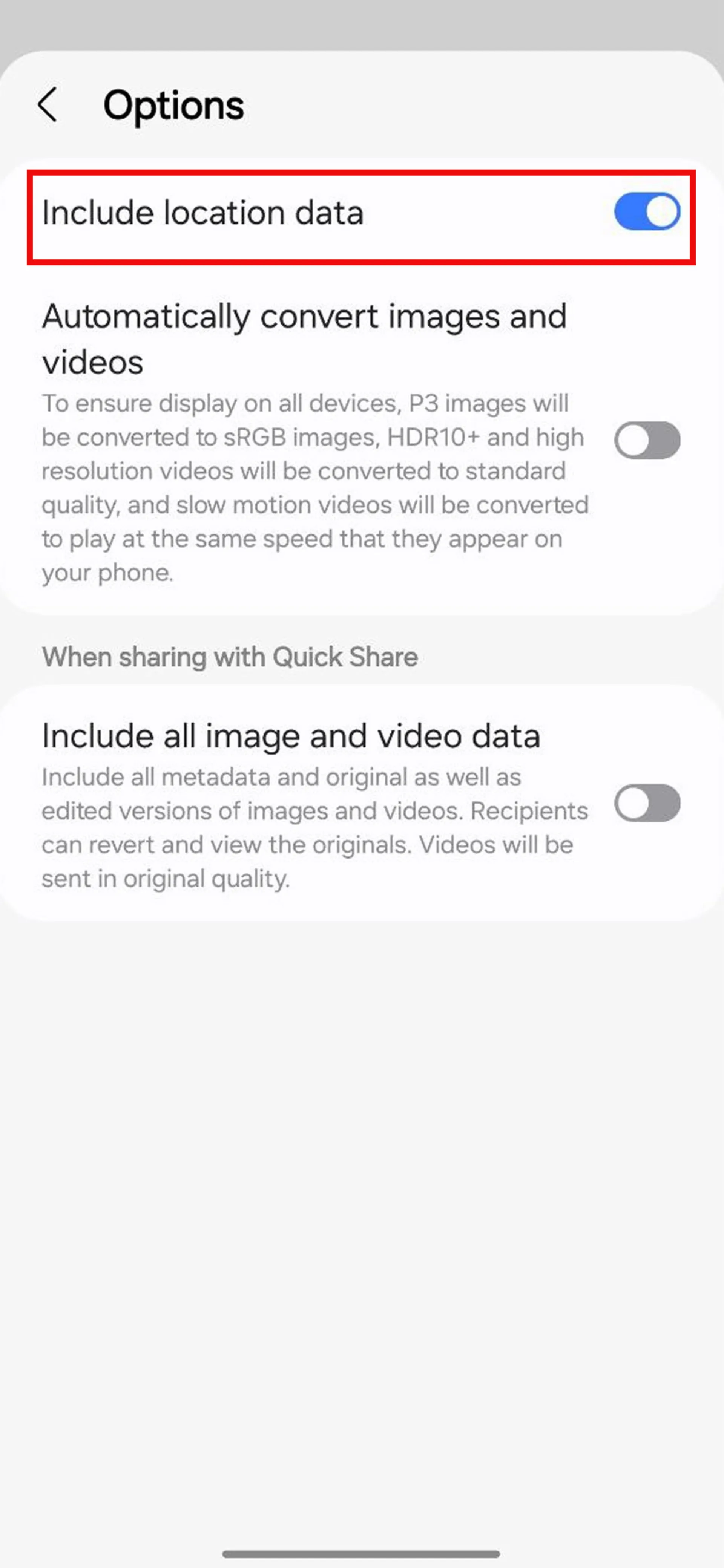
- In Xiaomi phones, it is enough to enter the Secure sharing section from the gallery settings and turn off the two options Share without location info by default and Share without metadata by default.


If your Android phone gallery does not have the option to remove location information, use the two applications that are introduced below in the section on batch removal of EXIF and location information from photos.
Remove location from photos on iPhone and iPad
- Open the photo and tap on the three dots (…) icon.
- Select the Adjust Location option.
- Tap Remove Location.

Remove location from photo in Windows
- Right-click on the photo and select Properties.
- Go to the Details tab .
- Click on Remove Properties and Personal Information.
- Select the Latitude and Longitude option under GPS and click OK.

Remove location from photo in Mac OS
- Open the photo in the standard Mac Preview program.
- Go to the menu Tools > Show Inspector.
- On the GPS tab, click Remove Location Info.

Batch removal of EXIF and location information from photos
Manually removing metadata from large numbers of images is tedious; To save time, there are several tools for removing metadata from photos and removing data from photos on Windows, MacOS, Linux, Android, and iOS, here are some of the best options.
Android tools
- Scrambled Exif


Scrambled Exif is a completely free, open-source app that makes it easy to de-decrypt photos taken on Android before sharing them. To remove metadata from photos, simply import them into Scrambled Exif via Android’s share menu. After a few moments, the sharing menu will appear again and you can share the photos whose metadata has been removed with the app of your choice.
- EXIF Image & Video Date Fixer


In addition to removing metadata, this program can correct the date and order of images and videos using EXIF metadata and filenames. It is also possible to modify the date manually and support batch processing. The free version can process up to 50 files simultaneously.
iOS tools
- Metapho


Through Metapho it is possible to manage metadata including viewing, editing, and deleting EXIF data. It includes batch editing, location spoofing, and secure sharing options. Viewing metadata is free; But for advanced features, you need to buy a subscription or a permanent license of the program.
- Exif Metadata


This tool allows you to easily view, edit, or delete metadata including GPS data. For batch processing of images, the paid version of the program must be purchased.
Windows, Mac, and Linux toolsExifCleaner
ExifCleaner for Windows works like the Mac version and allows you to delete batch EXIF files for free. ExifCleaner is also available for Linux with the same features as the Windows and Mac versions.
- EXIF Purge
A simple and lightweight tool to remove EXIF batches from images with one click. EXIF Purge is user-friendly and free; But it doesn’t support videos and PDFs.

Online tools
- Pics.io Metadata Remove

A free online tool that supports all types of files including images, videos, and PDFs, and there’s no limit to the number of files you can process.
- VerExif

Using VerExif, you can view and remove metadata from images. This website has a simple user interface and is free to use, But the images must be less than 20 MB.
By removing location data and other EXIF data from photos before sharing them, you can ensure that these images do not reveal unwanted information.
In addition to the introduced tools, countless options are available for removing and editing metadata from photos and videos; If you know of better tools, share them with us in the comments section
Technology
The chip battle of flagship phones in 2024; Which is the winner?
Published
2 days agoon
17/09/2024

PNoun: on an electrocardiogram.
Noun: An academic grade issued by certain educational institutions to indicate that a student passes a class.
Adjective: (used on a vehicle’s P-plate)
Adjective: (used on a vehicle’s P-plate)
Proper noun: The set of all problems that are solvable in polynomial time by a deterministic Turing machine
Verb: (of a quantity, etc.) To become larger or greater.
Verb: To make (a quantity, etc.) larger.
Verb: To multiply by the production of young; to be fertile, fruitful, or prolific.
Verb: To become more nearly full; to show more of the surface; to wax.
Noun: An amount by which a quantity is increased.
Noun: For a quantity, the act or process of becoming larger
Noun: offspring, progeny
Noun: radiotelephony clear-code word for the letter H.
Proper noun: named after Calvin F. How Jr.
The chip battle of flagship phones in 2024; Which is the winner?
Choosing the best flagship smartphone in today’s market is no longer just about choosing the most expensive option. While price is likely to be considered as a primary indicator, it is very difficult to make the right decision without adequate knowledge of technical specifications and key metrics. Ignoring these criteria can lead to incorrect selection. So what is the best chip for smartphones?
In choosing the best flagship phone in the market, various criteria are considered; From photography experience battery life, and clear display to software and design and price tag. These cases are usually easy to check, and conclusions can be drawn within minutes; But if the criterion is the power of the chip, the comparison will be challenging.
In the discussion of chip power, various criteria are involved; Including processing performance, which is one of the important criteria for choosing the most powerful phone in the market. A smartphone should be able to perform all daily tasks, including opening apps, browsing the web, running games, and managing background apps at high speed and without lag. One of the important features of smartphone chips is the number of cores. Some cores are designed for light tasks with low energy consumption, and others for heavy and graphic processing. Note that the number of cores is not the only factor that increases the speed, but their architecture and optimization also have a great effect.
Graphical capabilities are also of particular importance. Graphics processors (GPU) are responsible for processing games and graphic programs. On the other hand, battery consumption is one of the most important influencing factors in choosing a phone, which is directly related to the optimality of the chip. A smartphone with a high processing power, but a weak battery, cannot meet the daily needs of users well.
The stability of the chip during heavy usage should also be considered. Phones that slow down or increase body temperature under heavy pressure, such as running graphic games or complex programs, usually do not provide a good user experience.
Considering these parameters, it is challenging to choose a smartphone without having detailed information about the chip’s performance; That’s why we decided to put the most powerful chips on the market against each other to see which one matches the user’s needs by carefully examining the technical specifications and benchmark results.
-
Which chips?
-
Qualcomm Snapdragon 8 Generation 3
-
Apple A17 Pro
-
Samsung Exynos 2400
-
Mediatek Dimension 9300
-
Google Tensor G4
-
Comparison of processing performance
-
Comparison of graphics processing similar to the game
-
Comparison of battery life and power consumption
-
Comparison of stability in heavy processing
-
Summary: Which is the winner of the competition?
Which chips?
In the next article, we are going to review and compare the most powerful chips inside the 2024 flagship phones. These chips include Snapdragon 8 generation 3 from Qualcomm, A17 Pro from Apple, Dimension 9300 from MediaTek, Exynos 2400 from Samsung, and Tensor G4 from Google. In the following, we will try to review the strengths and weaknesses of each chip by comparing the Zomit benchmark results in order to reach a suitable conclusion about their performance.
Considering that the A18 Pro chip of the iPhone 16 Pro was released in the last months of 2024, we will compare the performance of this chip with 2025 flagship phones equipped with chips such as Snapdragon 8 generation 4 in another article.
Qualcomm Snapdragon 8 Generation 3
The Snapdragon 8 generation 3 chip (which we call S8G3 for short) was unveiled at Qualcomm’s technology conference in October 2023 (Mehr 1402).
Using Cortex v9 technology, this new processor has been able to operate about 30% faster than its previous generation, and its energy consumption has been optimized by 20%.
Also, by providing facilities such as Snapdragon Elite Gaming and Adreno Frame Motion Engine, the gaming experience has been improved by about 12% compared to the generation.
 Snapdragon 8 generation 3 entered the market with one goal: to conquer the battle between flagships
Snapdragon 8 generation 3 entered the market with one goal: to conquer the battle between flagships
In the field of artificial intelligence, the S8G3 chip can perform complex calculations in a shorter time by improving its performance by 98%. This feature is especially useful in applications such as machine learning and image processing and enables interesting features such as Sketch to Image in Samsung’s new foldables.
Apple A17 Pro
Every year Apple releases a new chip with the introduction of the new iPhone generation. Last year’s chip was called A17 Pro and it was exclusively used in iPhone 15 Pro and 15 Pro Max; The chip is built on TSMC’s 3nm manufacturing process, making it the first member of the 3nm family in the industry.
The A17 Pro chip has a 6-core configuration: two high-performance cores and four high-performance (and low-power) cores. High-performance cores are 10% faster than the previous generation, and low-power cores handle everyday tasks that don’t require high speed but help optimize battery consumption.
The graphics processing unit of the A17 Pro has also undergone major changes. This six-core GPU is up to 20% faster and provides more stable performance in games with less energy consumption. Also, for gamers, it offers MetalFX functionality to increase the graphic details of games while controlling battery consumption.
The A17 Pro chip also uses an advanced neural engine that can perform up to 35 trillion operations per second. The A17 Pro’s AI and machine learning capabilities provide new features such as more accurate auto-correction, background blurring in portrait photos, and personalized voice creation for people with speech impairments.
All in all, Apple’s chip has become one of the most powerful and efficient mobile chips by combining advanced architecture, energy consumption optimizations of up to 15%, and artificial intelligence capabilities, which not only provide great performance but also improve the user experience in various areas. forgives
Samsung Exynos 2400
Rumors about the Exynos 2400 chip were first heard in early 2023. The Exynos 2400 chipset acts as the beating heart of the Galaxy S24 and S24 Plus in some versions, but it is not present in the Ultra model. Recently, Samsung announced that it will launch all 2025 Galaxy flagships (S25 family) with Snapdragon chips only.
In this product, Samsung has used a different configuration of 1+2+3+4, which includes a total of 10 cores: one high-performance Cortex-X4 core with a frequency of 3.2 GHz, two Cortex-A720 cores with a frequency of 2 9 GHz, two A720 cores with a frequency of 2.6 GHz and four low-power Cortex-A520 cores with a frequency of 1.92 GHz. This combination allows the processor to operate optimally in energy consumption while having high processing power.
On the other hand, the Xclipse 920 graphics processor, which was also used in the Exynos 2200, using AMD’s RDNA 2 architecture and ray tracing capabilities, showed a higher potential by showing a 58% improvement in graphics performance in the 3DMark benchmark. is

One of the outstanding strengths of the Exynos 2400 is the 14.7 times increase in AI computing performance compared to the Exynos 2200. The upgrade improves the chip’s ability in areas such as text-to-speech summarization, simultaneous translation of conversations, and image generation.
Mediatek Dimension 9300
For the first time, MediaTek has used only powerful cores in the Dimension 9300 (MT6989) chip, abandoning low-power cores. According to MediaTek CEO Joe Chen, “Dimensity 9300 is MediaTek’s most powerful flagship chip to date, bringing extraordinary computing power with its unique All Big Core design.”
Taking advantage of the concept of “only big cores”, Dimension 9300 consists of eight powerful cores, including four Arm Cortex-X4 cores and four Cortex-A720 cores. This combination provides up to 67% better processing power than Dimension 9200, and It is
In addition, MediaTek has increased the cache memory by 29%, increasing its capacity to 18 MB. This upgrade not only increases the speed and efficiency of the chip in performing complex tasks but also improves the simultaneous management of multiple applications.

Mediatek
The Dimension 9300 also supports hardware ray tracing, which is commonly used in high-end PCs and game consoles. Although this technology is in its early stages in the mobile world, the Dimension 9300 chip allows developers to create games with stunning visual effects.
In addition, Dimension 9300 uses the world’s first hardware-based artificial intelligence engine. This artificial intelligence processing unit can improve the graphics performance of games by up to 25% (for processing graphics floating point data), adjust settings for optimal performance and even predict user behavior, with support for advanced language models such as MetaLlama 2 and Baidu. AI LLM provided the basis for the development of diverse and efficient artificial intelligence programs.
Google Tensor G4
On August 13, 2024, Google introduced the Pixel 9 series, which has a new G4 tensor chip at its heart. According to Google, the new chip makes the device one of the “smartest” phones on the market.
The Tensor G4 has a 7% higher clock speed than the Tensor G3, and its GPU is also 6% faster. In general, the G4 tensor has up to 10% performance improvement compared to the G3 tensor.
Tensor G4 processor is a custom chip designed and produced jointly by Google and Samsung with 4nm architecture. Tensor G4 with eight processing cores and using the Cortex-X4 core allows users to enjoy optimal performance and high processing power. Also, the A720 and A520 cores help maintain efficiency and stable performance.
One of the outstanding features of the Tensor G4 is the Arm Immortalis-G715 GPU, which significantly improves the visual quality of games and graphics-heavy applications with support for hardware ray tracing.
In addition, Tensor G4, thanks to the DeepMind team, can run complex artificial intelligence models such as Jumna Nano at a faster speed, allowing users to benefit from advanced capabilities such as voice recognition, image processing, and environmental awareness, directly on their device. become
Using Samsung’s 4nm LPP+ process, Tensor G4 has been able to provide better efficiency and thermal management than G3. Google claims that Tensor G4 can revolutionize the smartphone user experience by combining high processing power, optimal energy consumption, advanced graphics capabilities, and support for artificial intelligence.
Smartphones equipped with G4 tensor
Comparison of processing performance
In this section, we will examine the processing power of the introduced chips. But before the comparison, it is worth taking a look at the technical specifications of these chips:
|
Specifications |
Snapdragon 8 Generation 3 |
A17 Peru |
Exynos 2400 |
Dimension 9300 |
Tensor G4 |
|---|---|---|---|---|---|
|
The main processor |
8 cores 12 MB of L3 cache memory |
6 cores 256 KB of L1 cache memory 16 MB of L2 cache memory |
10 cores 8 MB of L3 cache memory |
8 cores 10 MB of L3 cache memory |
8 cores No cache information available. |
|
GPU |
Adreno chip Shading noise canceller Operating capacity of 4435.2 gigaflops |
Apple A17 GPU chip 6 processing lines 128 shading units Operating capacity of 2147.2 gigaflops |
Xclipse 940 chip Ray tracing support Operating capacity of 3407 gigaflops |
Arm Mali-G720 Immortalis chip Ray tracing Operating capacity of 5990.4 gigaflops |
Chip Mali-G715 MC7 Operating capacity of 2625.7 gigaflops |
|
Artificial intelligence processor |
Vector processing engine Hexagon DSP accelerator Scalar Accelerator Accuracy INT4 |
Powered by Apple’s Neural Processing Engine (NPU). |
2 low-consumption neural processors 2 powerful neural processors |
APU 790 chip Support for INT4 Hardware compression |
Google’s custom tensor processor |
|
memory |
LPDDR5X 4 bands of 16-bit Support up to 24 GB |
LPDDR5 4 bands of 16-bit Support up to 8 GB |
LPDDR5X 16-bit bus width Support up to 24 GB |
LPDDR5T 4 16-bit bass Support up to 24 GB |
LPDDR5X 4 16-bit bass Support up to 16 GB |
|
manufacturing process |
4 nm TSMC |
3 nm TSMC |
Samsung 4 nm |
4 nm TSMC |
Samsung 4 nm |
In the table below, you can see the CPU score of the chips in single-core and multi-core processing based on the official GeekBench 6 benchmark. The results of all chips except Dimension 9300 are obtained from Zomit tests.
|
product/chip |
GeekBench 6 |
|
|---|---|---|
|
single core |
multi-core |
|
|
Snapdragon 8 Generation 3 (Galaxy S24 Ultra) |
2262 |
7005 |
|
Apple A17 Pro (iPhone 15 Pro Max) |
2960 |
7339 |
|
Dimension 9300 (Vivo X100 Pro) |
*2007 |
*7408 |
|
Exynos 2400 (Galaxy S24) |
2148 |
6618 |
|
Tensor G4 (pixels) |
1710 |
3799 |
Snapdragon 8 generation 3 and A17 Pro both use powerful processing cores, but A17 Pro has better processing performance using Apple’s proprietary architecture and detailed optimizations. This difference is felt especially in single-core tasks, where Apple has been able to provide much higher efficiency.
On the other hand, Dimensity 9300 has a very powerful performance in multitasking and running heavy programs and even surpasses A17 Pro by five percent. This issue is especially evident in situations where multiple processes are running at the same time.
Dimension 9300 showed a very powerful performance in processing benchmarks. This chip was able to challenge S8G3 and A17 Pro chips in multi-core tests. It can be said that Dimension 9300 has a higher position than its competitors in the field of multi-core processing, by sacrificing energy efficiency; But it still can’t reach the level of the A17 Pro in single-core tasks (two percent weaker) and is almost at the same level as the S8G3. Due to the good performance and relatively lower cost of phones equipped with Dimension 9300 compared to competitors, this chip offers users an efficient option.
The Exynos 2400 performs well in multitasking and heavy computing overall, but compared to the A17 Pro and Snapdragon 8 Gen 3, it still lacks in some areas such as single-core performance (5% weaker than the S8G3 and 27% lower than the A17 Pro). . Due to Samsung’s optimizations, this chip has an acceptable performance in Samsung devices, but it falls short in the competition with Qualcomm and Apple.
Although Tensor G4 is more focused on artificial intelligence processing, compared to other chips in the field of general processing, it shows weaker performance. With this chip, Google has tried to provide improvements in certain areas such as camera-related processing and machine learning, but it is still far from competing with the A17 Pro and Snapdragon 8 Gen 3. Pixels equipped with G4 tensor will be a good option for users who are looking for a different experience, but it won’t work for people who care about powerful performance in most areas.
Comparison of graphics processing similar to the game
In this section, we compare the graphics capabilities of the chips in-game rendering based on the GFXBench benchmark. Each of these chips uses an advanced graphics processor that provides a satisfying experience in running games and programs.
|
product/chip |
GFXBench (with reference display resolution) |
|---|---|
|
Snapdragon 8 Generation 3 (Galaxy S24 Ultra) |
81 |
|
Apple A17 Pro (iPhone 15 Pro Max) |
46.8 |
|
Dimension 9300 (Vivo X100) |
83 |
|
Exynos 2400 (Galaxy S24) |
68 |
|
Tensor G4 (pixel 9) |
44 |
These numbers are based on Aztec Ruins High Tier Offscreen. A higher number indicates better performance.
Snapdragon 8 Gen 3 with its advanced GPU that supports ray tracing technology is one of the best options for gamers. Compared to Apple’s A17 Pro, which uses Apple’s own GPU, this chip offers better performance in some graphics-heavy games. The benchmark results show a very close competition between S8G3 and Dimension 9300 chips. That being said, it would be fair to consider the top ranking for both chips jointly.

A17 Pro does not perform satisfactorily in graphics processing, because Apple focuses more on optimizing energy consumption, and as a result, it may not appear as powerful as Dimension 9300 and S8G3 in some graphics tests. In any case, getting the fourth place in this table is not far from the expectation; If you go back to the processor details comparison table, the A17 Pro’s GPU performance is 2.8 times lower than the Dimension 9300 chips, about half of the S8G3, and even 1.5 times lower than the Exynos 2400.
According to the results of both benchmarks, Dimension 9300 has close competition with Snapdragon 8 generation 3 and according to the numbers, it is placed beyond it. Using Immortalis-G720, Dimension 9300 has provided an impressive performance and has an absolute and significant advantage over A17 Pro in playing heavy games and advanced graphics programs, and has been able to provide a smooth and satisfying experience to users.
Exynos 2400 uses the Xclipse 940 GPU, which is based on AMD’s RDNA 3 architecture. Using this chip, Samsung has been able to provide satisfactory performance in graphics games, but it is 16% behind Qualcomm’s flagship and 19% behind MediaTek. The interesting thing about this chip is its 45% advantage over Apple A17 Pro.
In some heavy games, the Samsung chip may have lower performance due to less thermal management. Despite the Exynos’ impressive improvements, Qualcomm’s graphics unit still has a significant edge in rendering.
Although Tensor G4 focuses more on software optimizations and processing related to cameras and artificial intelligence, compared to competitors, it shows weaker performance in the field of graphics. This chip may face challenges in heavy games like Call of Duty or Genshin Impact. Therefore, Tensor G4 is a suitable processor for light games.
Comparison of battery life and power consumption
Optimizing energy consumption is one of the other factors affected by the chip, which has an impact on choosing the best phone. This issue is especially important during long-term use of the device and when running heavy programs.
Because each chip may have been released in a smartphone with a different battery capacity, we have used a new benchmark in the table below for equal comparison. To obtain this new benchmark, we perform several different activities (calls, games, web browsing, video playback) with each phone in order to drain the battery. Then we divide the weighted average of the device’s activity time (in minutes) by the battery capacity (in amp hours). You may be asking yourself:
Why division?
Because of the direct relationship between the charging time and battery capacity. Longer charge-discharge time should be a positive factor in the calculation of the criterion; While increasing the battery capacity is a factor unrelated to the chip.
The resulting number indicates that the operation of the chip consumes 1000 mAh of energy in a few minutes. We use the GSMArena benchmark to make the charge drain times fair.
|
product/chip |
Battery capacity (ampere-hours) |
Activity time (minutes) |
Reduction comparison criteria Charging (minutes/amp hours) |
|---|---|---|---|
|
Snapdragon 8 Generation 3 (Galaxy S24 Ultra) |
5 |
829 |
165.8 |
|
Apple A17 Pro (iPhone 15 Pro) |
3.29 |
961 |
292.1 |
|
Dimension 9300 (Vivo X100 Pro) |
5.5 |
833 |
151.4 |
|
Exynos 2400 (Galaxy S24) |
4 |
726 |
181.5 |
|
Tensor G4 (Pixel 9 Pro XL) |
5.06 |
752 |
148.6 |
Benchmark for fair comparison of power consumption of flagship chips
A17 Pro has been able to achieve the best performance in this field with its special focus on energy efficiency. Due to its high energy efficiency, this chip can significantly increase the battery life of iPhone devices (at least two hours more than competitors) and at the same time have stable performance in heavy applications.
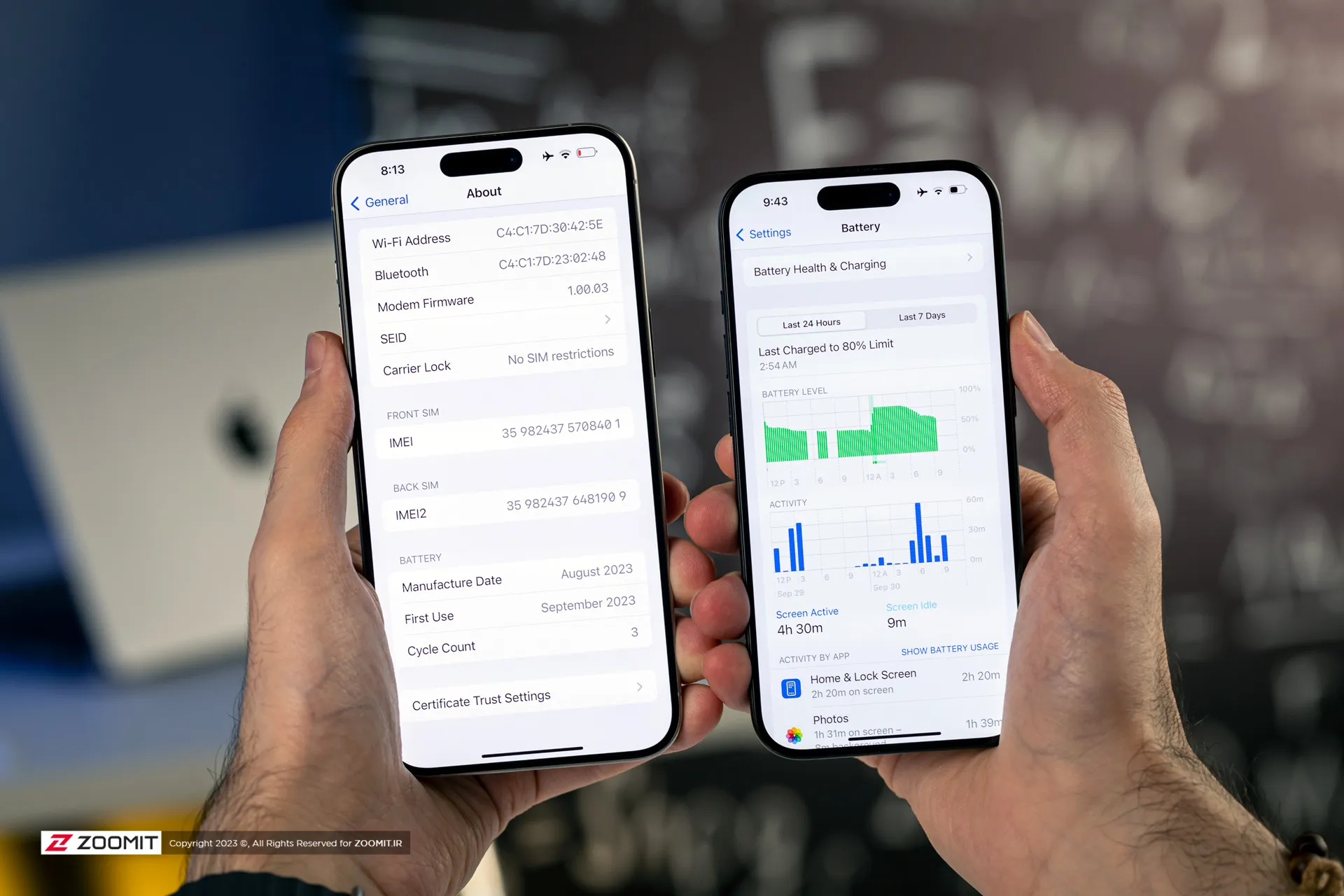
Snapdragon 8 generation 3 also minimizes energy consumption by using optimal architecture and advanced technologies, and while it has high processing power, in the field of energy consumption optimization, it offers 14 minutes more energy per amp hour than Dimensity 9300; But it still doesn’t reach the peak of A17 Pro (130 minutes more hours per amp hour). Meanwhile, Qualcomm’s chip is 10% behind Samsung’s Exynos 2400 in terms of energy efficiency.
Dimension 9300 also minimizes energy consumption and has high energy efficiency by using new technologies and optimizations. The chip outperforms the competition in the device battery life benchmark, but it still lags behind the A17 Pro when it comes to battery life. Don’t forget that MediaTek only used high-power cores in the Dimension chip and it is not far from the expectation that it does not provide optimal consumption. This fact makes most phones with this chip need to use a battery with a high nominal capacity to provide proper charging for users.
The Exynos 2400 is surprisingly energy efficient and consumes less power compared to MediaTek and Qualcomm chips. Let’s not forget that this chip with 10 cores holds the record for the highest number of cores in this comparison. With this chip, Samsung has tried to create a balance between performance and energy consumption, and it seems to have succeeded in this; But this success has a heavier bottom in favor of energy consumption.
The Tensor G4 optimized power consumption in these areas by focusing on AI and special processing but is more power-hungry compared to other chips, especially in general graphics and gaming (using 1 amp hour per 148.6 minutes). The chip is suitable for users looking for an AI-based experience, but it still needs improvement in terms of general energy efficiency.
Comparison of stability in heavy processing
In the world of smartphone technology, the stability of chips under challenging conditions is very important. We used the 3D Mark Wildlife Stress Test to check the stability of the investigated chips. This test provides the final score and percentage of stability by checking the performance of the device in heavy processing. This percentage shows how well the device can maintain its performance over time; The higher the percentage, the more stable the chip.
|
product/chip |
Percent stability |
|---|---|
|
Snapdragon 8 Generation 3 (Galaxy S24 Ultra) |
52 |
|
Apple A17 Pro (iPhone 15 Pro Max) |
78.9 |
|
Dimension 9300 (Vivo X100 Pro) |
55.5 |
|
Exynos 2400 (Galaxy S24) |
63.4 |
|
Tensor G4 (Pixel 9 Pro XL) |
68.3 |
Snapdragon 8 generation 3, despite the significant improvement in processing power and graphics, does not show very good stability and is placed at the bottom of the ranking list. This generation shows even less stability than the previous generation (with 64%).
Apple’s A17 Pro has been very successful in this field due to the use of advanced technologies. By using a proprietary architecture and focusing on software optimizations, Apple produced a chip that has stable and fast performance even under the most challenging conditions, but in some situations, its performance may drop slightly due to the focus on optimizing energy consumption (see the graphic comparison table). see).

Dimensity 9300 despite its high ability to manage heavy tasks, in some cases due to higher temperature, may suffer a slight decrease in performance stability. The difference of 3% in the reported numbers shows the close rank of stability of this chip to Snapdragon.
The Tensor G4 lags behind the competition in areas such as processing and graphics but ranks well in terms of performance stability.
Samsung’s Exynos 2400, with 10 processing cores and a 70% improvement in CPU performance compared to Exynos 2200, has managed to gain a good place among flagship chips.
Summary: Which is the winner of the competition?
Finally, after considering all aspects, we can rank the current flagship chips based on overall performance, power efficiency, and cost:
- Snapdragon 8 generation 3: This chip is a good choice for Android users with its extraordinary graphics power and excellent performance in multitasking processes. With this chip, Qualcomm was able to compete shoulder-to-shoulder with Apple and even surpass it in some areas. The Achilles heel of this chip is the performance stability during heavy processing and the single-core performance is weaker than A17 Pro.
- Dimension 9300: By providing a powerful and optimal chip, MediaTek has been able to prove its superior position at the top of the comparison table. Due to the higher power consumption of this phone with powerful cores, the said chip is used in phones that have larger batteries than others. Small chip stability and thermal problems are unavoidable considering the target market.
- A17 Pro: Despite its high processing power and unparalleled energy efficiency, this chip ranks in the middle of this comparison due to its average graphics performance in-game rendering. With detailed optimizations and a focus on very stable performance, Apple introduced the A17 Pro as a powerful chip against competitors; However, this chip has given the user a longer battery life by sacrificing graphics processing power.
- Exynos 2400: Samsung has provided good performance with this chip, but it still needs improvement in some areas. This chip has moderate performance stability and lags behind in terms of graphics processing compared to Apple and Qualcomm chips.
- Tensor G4: Google has introduced this chip with a focus on artificial intelligence and specific user experiences; But compared to other chips, especially in the field of general and graphic processing, it has much weaker performance.
Finally, we can conclude that Snapdragon 8 generation 3 and Dimension 9300 are jointly known as flagships of almost everything in the world of smartphone chips and can handle all the processing and graphics needs of users; However, the performance stability is weaker than Apple chip. Along with them, the A17 Pro chip is a very good choice for those who ignore high graphics power and expect great processing power and longer battery life than other flagships. Finally, in the bottom ranks of the table, we can comment on the superiority of Exynos 2400 over Tensor G4. The G4 chip is clearly inferior to its competitors in CPU processing, game rendering, and energy efficiency. Google has a difficult road ahead to compensate for this gap.


Why do none of the moons of the solar system have rings?


The biography of Andy Rubin, the creator of Android


How to prevent your location from being revealed through photos?


The chip battle of flagship phones in 2024; Which is the winner?


Do animals have an understanding of the concept of death?


How to use iMessage on Android?


Xiaomi Glorimi M2 Max watch review; Alternative economic option for iPhone owners


Why do we humans sleep?


What is the difference between the brain of athletes and the brain of normal people?


Artificial intelligence problems; Frauds based on artificial intelligence and methods to deal with them
Popular
-



 Technology1 year ago
Technology1 year agoWho has checked our Whatsapp profile viewed my Whatsapp August 2023
-



 Technology1 year ago
Technology1 year agoSecond WhatsApp , how to install and download dual WhatsApp August 2023
-



 Technology1 year ago
Technology1 year agoHow to use ChatGPT on Android and iOS
-



 AI2 years ago
AI2 years agoUber replaces human drivers with robots
-



 Technology1 year ago
Technology1 year agoThe best Android tablets 2023, buying guide
-



 Technology1 year ago
Technology1 year agoThe best photography cameras 2023, buying guide and price
-



 Humans2 years ago
Humans2 years agoCell Rover analyzes the inside of cells without destroying them
-



 Technology1 year ago
Technology1 year agoHow to prevent automatic download of applications on Samsung phones











